 By Staff By Staff
January 3rd, 2018
BURLINGTON, ON
The video runs for just over four minutes – you come away with a sense as to part of the direction Mary Lou Tanner had as the former Director Planning for the city and what she expects she will be doing as the newly minted Deputy City Manager.
The interview was done by Colleen DePodestga of Remax Escarpment Real Estate.
During the interview we learned that “Granny flats” are going to be (are?) legal in Burlington. When asked how millennials can get to live in Burlington Tanner said … well it is all in the video – worth listening to.
It is all here.

 By Greg Woodruff By Greg Woodruff
January 2nd, 2018
BURLINGTON, ON
Staff have recently announced a new schedule for passing the revamped “Official Plan.” The staff proposed timing is completely unacceptable. This new Official Plan represents a radical change to the city. It contemplates eventually increasing the population by hundreds of thousands of people, allowing hi-rises on thousands of properties with no notification to adjacent owners, removing traditional commercial sites everywhere, making completely unknown modifications to transit and imposing completely unknown costs for it all.
Placing the vote on a decades long plan in April, just one month before the 2018 election season starts in May, seems to deliberately avoid democratic input. Even if the timing is quite innocent, the appearance of impropriety alone demands that the vote be moved off to the next elected council. Staff should spend the next months finalizing a completed Official Plan, completed Mobility Hub plan, and completed Transit Master Plan, with costs. Then we can all have an election on the merits of all of these plans, and costs, and move forward with a mandate and the understanding of the population.
The new plan contains no mechanism to preserve the quality of life for residents; each day seems to have less tree cover, less greenery, fewer local services, more people, more pollution and more time wasted traveling around a congested city. These negative effects are imagined to be offset by a plan for a massive switch to non-vehicular transportation that will be discovered in the future, but has not been presented or costed today. It treats existing citizen’s investment in their property, travel patterns and the lives they have built in Burlington as an inconvenience to be swept away. That theoretical efficiencies in energy consumption or land use might occur on a planning spreadsheet is not sufficient justification to draft 185,000 taxpayers into a radical irreversible experiment.
Additionally, the possible closing of citizen delegations before upcoming official plan votes looks equally bad.
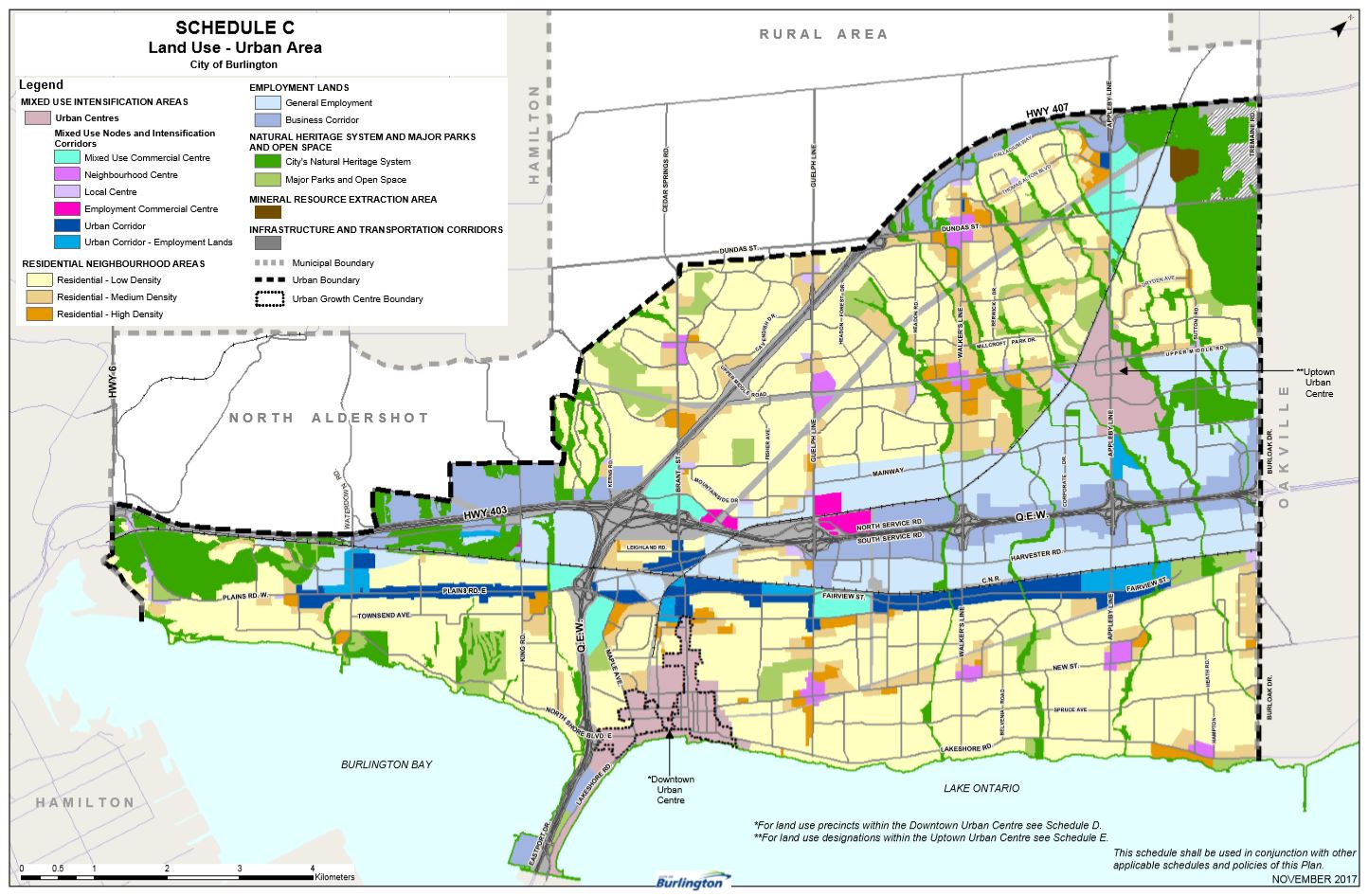 The effects of the rules and definitions in the new Official Plan requires detailed study, and the public needs much more time to provide proper feedback to council. As one quick example – at first the coloured map (Schedule C) shows pink for “Neighbourhood Centre”, and would seem to protect those traditional commercial sites. This is until you realize that the “Neighbourhood Centre” designation requires re-development to “To ensure the in-filling of surface parking lots (8.1.3.4.1.f).” The effects of the rules and definitions in the new Official Plan requires detailed study, and the public needs much more time to provide proper feedback to council. As one quick example – at first the coloured map (Schedule C) shows pink for “Neighbourhood Centre”, and would seem to protect those traditional commercial sites. This is until you realize that the “Neighbourhood Centre” designation requires re-development to “To ensure the in-filling of surface parking lots (8.1.3.4.1.f).”
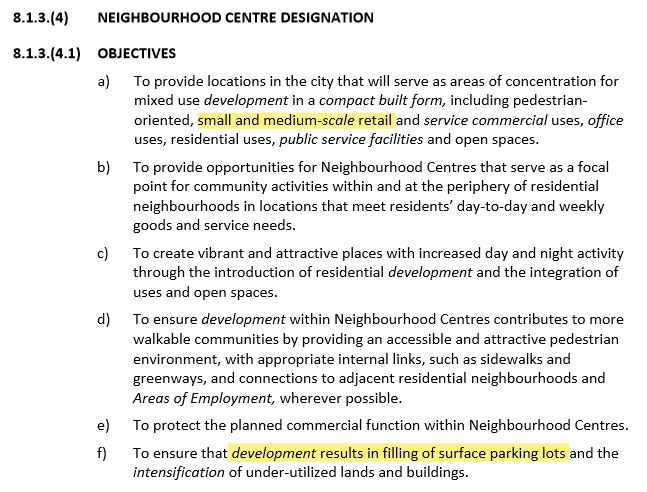 Some of the rules attempt to distort the free market further and remove surface parking in exchange for allowing 12 story buildings on the site. It’s completely unclear what replaces all these traditional commercial sites, or how the commodities of living are to be acquired. Some of the rules attempt to distort the free market further and remove surface parking in exchange for allowing 12 story buildings on the site. It’s completely unclear what replaces all these traditional commercial sites, or how the commodities of living are to be acquired.
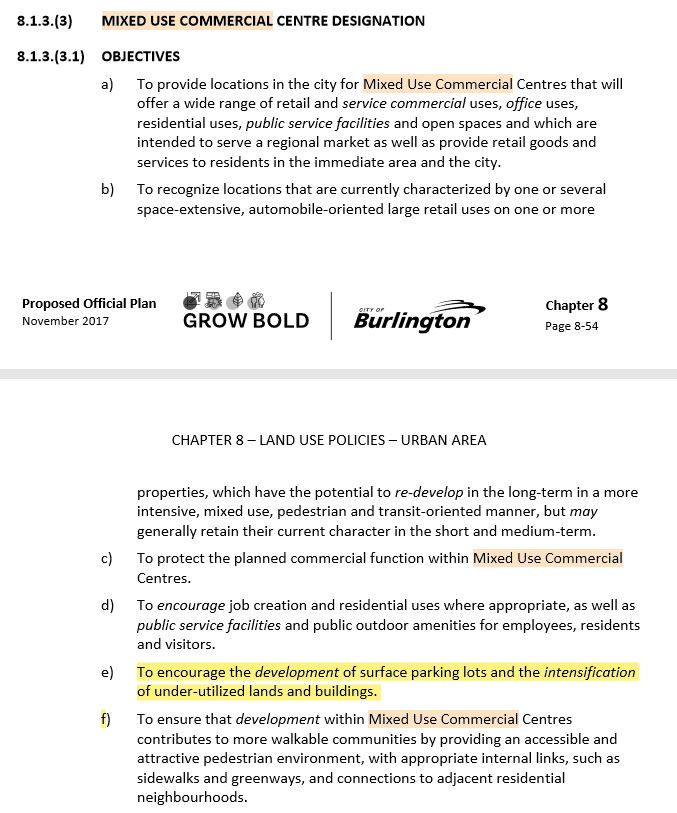 It seems as if the current population is to just blindly begin these changes then endure whatever local fallout occurs. It seems as if the current population is to just blindly begin these changes then endure whatever local fallout occurs.
Though Councillors have a provincial direction to review and update the plan with staff, they certainly have no requirement to pass the plan in the current term. Population targets are set out at 2031, which leaves a decade or more before any tisk-tisking might even come from the Province. The current time line is simply not imposed by the Province. However, using this as a pretext again makes it seems like the real purpose of the timing is to remove the discomfort of Councillors and staff having to defend something they suspect voters are unlikely to support.
There is far too much focus on intensification for population numbers alone, and too little on positive intensification to enrich our communities. A focus is needed on quality of life, not the quantity of people. If the plan is worth voting for now, then it should be easy to get re-elected promoting it.
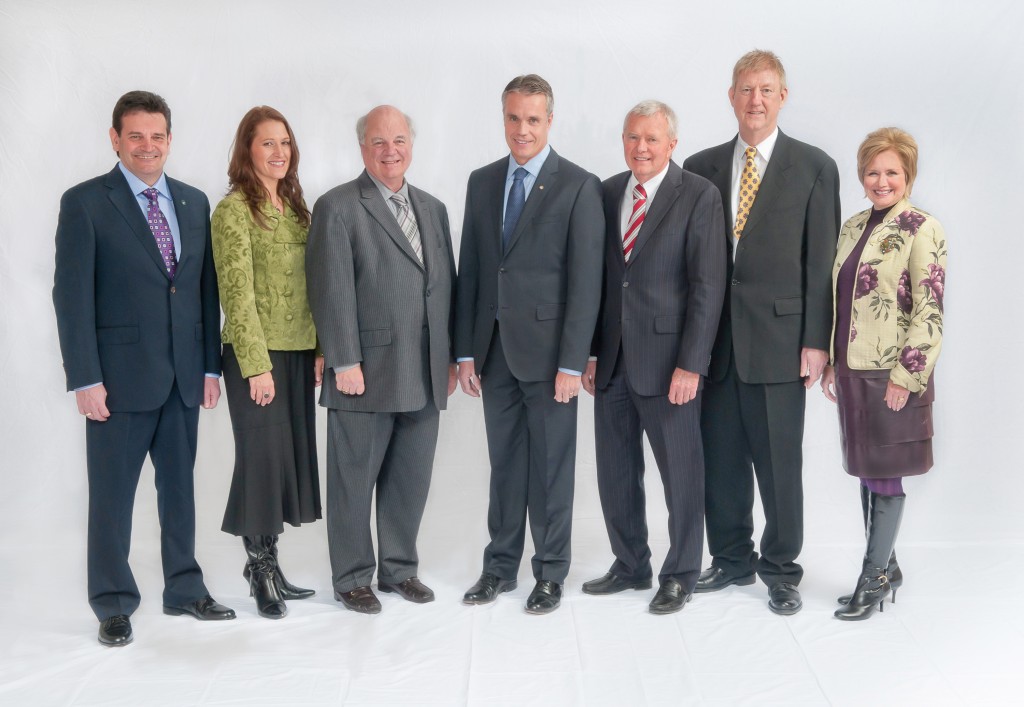 Are they prepared to stake their council seats on the Official Plan that is being proposed? If members of Council don’t think they can get re-elected supporting it, then they should not vote for it now. It’s that simple. Changes this radical require a mandate, and this Council can help more than ever by making sure it exists for the next Council.
Please help everyone now by defending the people’s impression of our democracy which has placed Council in a position of trust.
 Greg Woodruff is an Aldershot resident who ran for the office of Regional Chair in the 2014 municipal election. He delegates frequently at city council. Greg Woodruff is an Aldershot resident who ran for the office of Regional Chair in the 2014 municipal election. He delegates frequently at city council.

 By Rory Nisan By Rory Nisan
January 2nd, 2018
BURLINGTON, ON
“May you live in interesting times” — an English expression commonly attributed as a Chinese curse, and an appropriate characterization of the situation in Burlington at the beginning of 2018.
 Without a doubt, 2017 was a year of some turmoil in our community. Two of our schools are on the chopping block and the campaign of the Halton District School Board to close schools come hell or high water has without a doubt been a source of civil conflict in our community. Without a doubt, 2017 was a year of some turmoil in our community. Two of our schools are on the chopping block and the campaign of the Halton District School Board to close schools come hell or high water has without a doubt been a source of civil conflict in our community.
And more recently, Burlingtonians have contended with drastic proposed changes to the city’s official plan, causing outrage among many (and satisfaction for others) as Burlington feels the effects of development agendas.
For those who are engaged on these issues, we enter 2018 with some trepidation. Will the approval of 421 Brant street stand? Will more proposals for sky scrapers at the bottom of Brant street come forward?
Will the 5-2 vote on the Brant street building be mirrored by a 5-2 vote in favour of the new Official Plan?
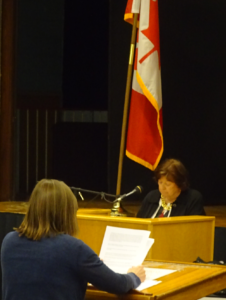 Margaret Wilson listening to a delegation during the Accommodation Review of the HDSB decision to close two high schools. Similarly, what will Margaret Wilson’s Accommodation Review of the HDSB Trustees’ decision to close Pearson and Bateman high schools contain?
As easy as it would be to be fearful for the future, I see many reasons to be optimistic. We are busy people: families, commuters and active retirees, among others. We could be forgiven for not always having our fingers on the pulse of local politics. After all, Burlington is one of the best cities in which to live in Canada.
I am truly impressed at how many stood up for what we believe in this year. I have been most active with the Save Pearson team and many of us were not engaged between elections prior to this issue coming forward.
That has all changed.
Now, moms and dads, alumni and grandparents are working together towards common aims. There are bonds forming, political and social, that will carry us into 2018.
We are seeing Burlingtonians coming together across cultural lines as well. Burlington is changing fast — it has never been as diverse. We could either become more inclusive, or more exclusive — neutrality is tantamount to giving permission for xenophobia to creep into our society. After the Mosque attack on 29 January 2017 in Quebec, we organized a vigil for the victims at city hall. The hundreds of people who attended and signed the condolence book were proof that Burlingtonians want and will take action towards a more inclusive city.
After that, we wanted a more happy occasion to celebrate inclusion and diversity, and so with the support of a dozen faith groups we pulled together the first-ever One Burlington Festival. We celebrated our different cultures and faiths with food, music, dancing and games on 22 August. I am excited to help make it an annual event with another One Burlington Festival in August 2018.
Finally, membership on the City of Burlington’s Mundialization Committee has afforded me the chance to meet several younger Burlington residents. I was never anywhere near as engaged as they are in their high schools years. It has been gratifying to mentor some of the younger members of UN Subcommittee in particular. They are truly impressive and now, at 35 years old, I am finally understanding why it is often said that youth are the future. I aspire to be as focused and determined to be an agent of change as these students.
 The next 12 months promise plenty of excitement. First, in June we will have a provincial election, which will bring fevered campaigning through the spring. Then, Burlington will hold its municipal election on 22 October along with the rest of Ontario. This one looks like it’s going to be interesting, with multiple competitive candidates for the Mayorship, and a strong probability that city council will not be fully re-elected as it was in 2014. The next 12 months promise plenty of excitement. First, in June we will have a provincial election, which will bring fevered campaigning through the spring. Then, Burlington will hold its municipal election on 22 October along with the rest of Ontario. This one looks like it’s going to be interesting, with multiple competitive candidates for the Mayorship, and a strong probability that city council will not be fully re-elected as it was in 2014.
What I will look for in 2018 is how Burlingtonians will build on the actions taken this year to fight for the city we want, with the schools we want, the downtown we want, and the roads and transportation we want, all coming together to build a city fit for purpose in 2020. I am hoping that a 2020 vision emerges through citizens’ engagement and that the upcoming elections unify Burlington rather than divide us, and put us on a path towards the kind of city we deserve.
Of course, it is not enough to hope from the comforts of the couch. It is critical to take action to be a part of the change that one wants to see, and that is what I will do.
Will you?
 Rory Nisan is a long-time Burlington resident and Lester B. Pearson High School alumnus. He has been an active member of the Save Pearson community organization. Rory Nisan is a long-time Burlington resident and Lester B. Pearson High School alumnus. He has been an active member of the Save Pearson community organization.

 By Staff By Staff
January 1st, 2018
BURLINGTON, ON
In our business we get media releases from city hall, from the Region, from the provincial government and from the federal government. Plus dozens of commercial organizations who want a mention. Nice to know that they think we matter.
The number coming in daily from the province tells you that something is up – and of course the expected election in less than six months means the media releases get cranked out for just about anything.
 There were two media releases today, that are not news but, point out to two changes the province has put in place that make sense in their own right and are examples of good government policy – they were the increase in the minimum wage to $14 an hour and a better deal for the minimum wage workers in terms of the time they can take off for sick days and personal matters. There were two media releases today, that are not news but, point out to two changes the province has put in place that make sense in their own right and are examples of good government policy – they were the increase in the minimum wage to $14 an hour and a better deal for the minimum wage workers in terms of the time they can take off for sick days and personal matters.
The hospitality sector has been crying poor over paying the people who take our orders and serve us our food a decent wage. Their hope was that our gratuities would make the job worthwhile.
 The other is described as OHIP plus which gives people under 25 all kinds of pharmaceuticals free of charge. The other is described as OHIP plus which gives people under 25 all kinds of pharmaceuticals free of charge.
There was a new story of a university student who had to come up with $500 a month to cover the cost of her medications. There is one vote the Liberals can count on.
Both new programs appeal to and were aimed at a demographic that has not been known for its engagement in things political.
Will these two offerings make a difference to the Liberal party’s fortunes? They are said to be behind the Progressive Conservative opposition in the popularity polls.
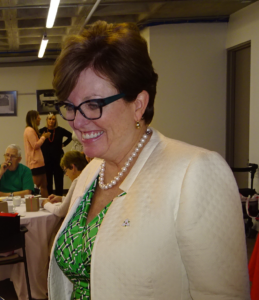 Burlington MPP Eleanor McMahon With the festive season behind us – expect to see a lot more election advertising and much more from the candidates. In Burlington the sitting MPP Eleanor McMahon, who is also a member of Cabinet and sits on the Treasury Board as well, will be on your doorstep. She is an accomplished campaigner – expect her to hold her seat.
While she should hold her seat she may return to Queen’s Park as a back bencher.
 Jane McKenna, Progressive Conservative candidate for Burlington in the June provincial election. The Progressive Conservatives brought Jane McKenna back after her loss to McMahon in YEAR. McKenna’s campaign is being run by former Member of Parliament Mike Wallace who has his hat in the ring for the job of Mayor.
They might have been better off running Wallace as the candidate for the provincial seat.
 Vince Fiorito – Green candidate in the 2014 provincial election – is expected to run as a candidate again. The New Democrats have yet to name a candidate. Vince Fioroto is reported to have agreed to run as the Green candidate. This time around he might actually campaign in Burlington – last time he spent much of his time in Guelph where the Greens thought they actually had a chance of winning that seat.
Burlington is represented by three people in the provincial legislature – the constituencies are: Burlington, Milton (covers the northern part of Burlington and Oakville North Burlington. Editorial on those constituencies will follow.

 By Pepper Parr By Pepper Parr
January 1st, 2018
BURLINGTON, ON
It always come down to a matter of trust.
Do you trust the person you are working with?
Do you trust the mechanic to fix your car?
Do you trust the grocer to sell you food that has not passed its best before date?
Trust doesn’t seem to go as far these days does it?
Learning that the largest supermarket operator in the country has been involved in the fixing of bread prices for more than ten years was a bit of a jolt. Many were stunned when they learned that Volkswagen was playing with the emission test results.
Hundreds of Ontario investors are out a lot of money because of foul play on the part of shady financial operators. These people wonder why the Ontario Securities Commission isn’t doing more to right the wrongs.

Thousands of Burlingtonians are close to furious with what they believe their elected officials seem prepared to let take place in terms of growth in the downtown core which they feel will destroy the city they love and live in.
Those same people question who the bureaucrats are working for and why recommendations they don’t believe reflect what the citizens want are sent to city council.
In 2010 the citizens of the city decided they didn’t like the way the then Mayor, Cam Jackson was doing his job and they turfed him. They elected a council that was quite a bit different led by a new Mayor they trusted.
Hold over Councillors Taylor, Dennison and Craven were re-elected. The sense was that Councillors Meed Ward, Lancaster and Sharman and a new Mayor was enough to change the way things were being done.
The electorate was satisfied enough to re-elect all seven members of city council which then let the bureaucrats foist a tag line on them that said:
Burlington is one of Canada’s best and most livable cities, a place where people, nature and business thrive.
The problem with the tag line is that it isn’t true – the “best city” part comes from a magazine that runs a poll each year and they declared the city was the “best”. The citizens of the city didn’t come to that conclusion – a publisher somewhere made that statement and the bureaucrats fell in love with it.
Far too many of the citizens are disagreeing with that statement – the trust that needs to be there is no longer in place.
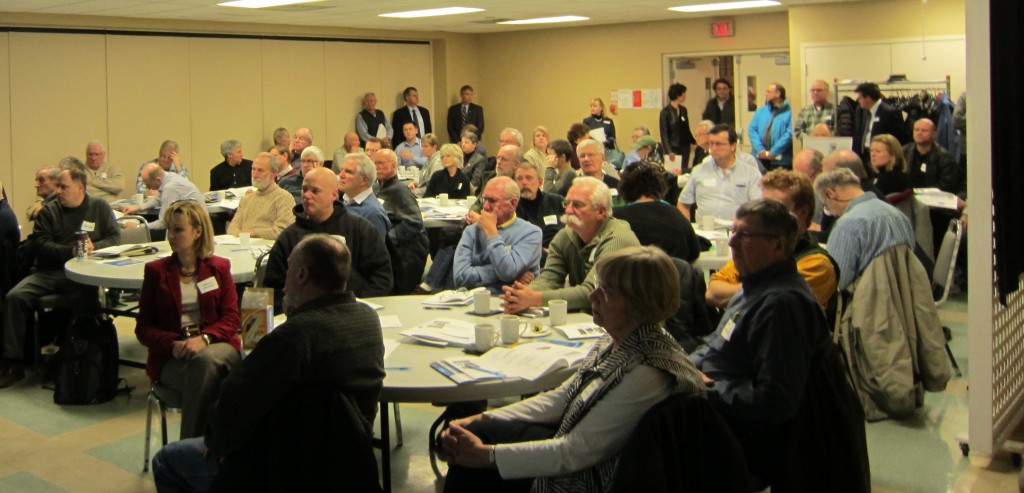 A rapt audience listened to an overview of a city budget. Make no mistake however that tens of thousands of the people that live in Burlington love their city – the way it is. They are not opposed to change but they want to be involved in the decisions that are made and when they speak they want to be heard.
When a group of well-meaning people take the time to gather names on a petition they don’t want to be belittled and denigrated by a member of council who suggest the names gathered are suspect.
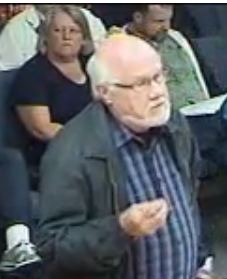 Monte Dennis delegating at city council. 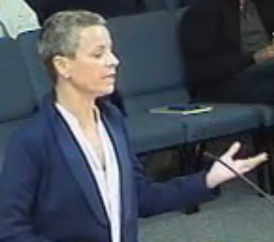 Vanessa Warren delegating at city council. People who don’t have much experience speaking to others don’t want to feel inadequate when they have finished their delegation and are not asked a single question.
 Gary Scobie delegating at city council  Jim Young delegating at city council Burlington is fortunate to have some very accomplished people who address council; this writer cannot remember a single situation where an idea put forward by a citizen has been taken up by council. With the exception of Councillor Meed Ward, none of the others offer to get back to the speaker and follow up. They may do so – but they aren’t seen to do so.
It is a trust issue which this council does not appear to hear or even understand.
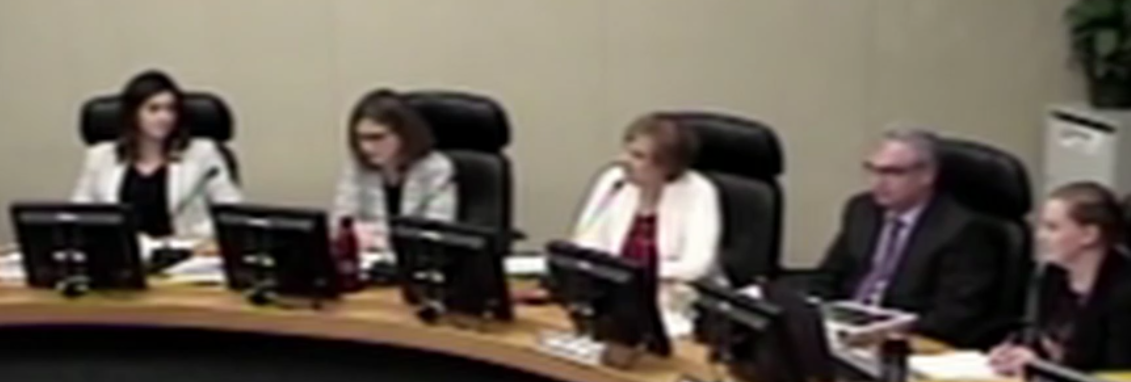 The quality of the image is terrible – the city has chosen not to invest in cameras that will produce a decent image. These are the messengers. 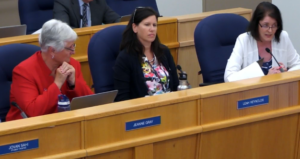 By way of example – the images from Board of Education meetings are clear – and their vote recording system actually works. Much of what city council is given in the way of staff reports infuriates intelligent, informed people who expect better. City managers serve at the will of council and they take their direction from Council. The bureaucrats are just the messengers – look to the people the bureaucrats serve for the kind of direction you want – and then press on to ensure that your message is heard.
And good luck – very few new faces wanting to become city council members have come forward. We are aware of two – need more than that. Four of the incumbents might not even be challenged.
Blame yourselves for what you have.
Salt with Pepper is an opinion column written by Pepper Parr, the publisher of the Gazette.

 By Ray Rivers By Ray Rivers
January 1st, 2018
BURLINGTON, ON
 Progressive Conservative leader Patrick Brown is said to be leading in the polls – will that lead hold? It’s Patrick’s Brown’s election to lose according to the pollsters surveying Ontario’s political landscape in advance of the 2018 vote. Of course the only poll that counts is the one on Election Day but his PC party has been topping the Liberals for the last two years. Kathleen Wynne’s Liberals are mired in second place, tied with the other centre-left party, the NDP, led by veteran Andrea Horwath.
 Premier Wynne has been to Burlington on numerous occasions. Anyone who will flip racks fo ribs has got to care about what happens in this city. Will this city be part of the province that returns her to office later this year? Wynne is generally seen as unpopular though it is hard to understand what she has done which might have offended the public. Horwath, on the other hand is more popular though still perceived as an unknown. Even after leading her party since 2009, and with a couple of elections more under her belt than her opponents, she and her party have failed to connect with the voters.
Patrick Brown is a breath of fresh air for a political party that has a history of too often catering to its socially divisive extreme right wing. He flew on that wing himself not so long ago, but obviously has found the other one and put together a balanced platform that, with a couple of exceptions, pretty much looks like what the other two leaders have been promising. The biggest question is whether he really means it.
Paint it any colour you like Ontario is moving smartly on a solid track and that means its Premier, Wynne, has been doing the right things – or at least most thing right. The budget has been balanced, electricity rates have been scaled back, unemployment levels are way down and the economy is booming. Wynne can also take credit for the expansion of the Canada Pension Plan as well as inflation-proofing and increasing Ontario’s minimum wage laws – measures intended to help address the needs of those who are victim to our ever growing income gap.
There is also good news for those eligible for free tuition and Pharma- care. But the electricity file has been a sore point for the Liberals, though in truth it has been that way for governments going back to at least Bob Rae. And thanks to Mike Harris and Dalton McGuinty there has been a huge transition in the province’s energy business including a greater role for the private sector and a revolution in how electricity is generated.
 Coal-fired electricity is a thing of the past. Few remember just how significant the changes to the provinces electricity supply system have been. To be sure, none of the parties will be bringing back coal-fired electricity nor resurrecting Ontario Hydro. There is, in fact, little disagreement on the fundamentals. It’s only on the edges that the parties are staking out territory. Brown has promised to somehow re-negotiate the iron-clad energy supply contracts downwards and put a stop to expansion of the electricity system. It’s true that today’s hydro bills include payments for electrons which gets delivered whether they are needed or not.
But the world is changing so fast that within a few years most automakers will finally be producing electric vehicles (EV) in quantities to rival and even exceed the gas guzzlers. And that will mean a rapid increase in electricity demand as gasoline stations start to disappear, becoming as rare as Blockbuster video stores and hen’s teeth. And then charging your EV at home overnight will cost you a lot more if Brown eliminates smart meters as he is also promising to do.
 The Smart Meters are apparently not smart enough for Patrick Brown, Climate change is being caused primarily by the greenhouse gases (GHGs) generated by fossil fuels. Ontario became the first jurisdiction to get rid of its coal-fired energy plants, one of which had been the largest point source of GHGs in Canada. Recently the federal government has mandated carbon pricing, a carbon tax, across the country to shift demand away from fossil fuels.
Ontario and Quebec have decided to meet that mandate through a ‘cap and trade program’ where GHGs would be capped and major players, e.g. oil companies, would have to buy quotas. Some of the costs of those quotas would be passed along to consumers when they fill their tanks, but the total cost of ‘cap and trade’ is generally less for an economy than a carbon tax.
That fine point is lost on Brown who would get rid of cap and trade and apply a flat carbon tax as Alberta and B.C. do. And like B.C. he would make it revenue-neutral, targeting income tax reductions for the middle class, thereby also making it mildly redistributive as well. Yet claims of over 20% in tax cuts will need to be weighed against the much higher prices for home heating and cooking fuels, public transportation and of course what you pay at the pump.
By definition revenue-neutral is like moving money from one pocket to another. But at least a carbon tax is an easier concept to understand and more directly consistent with the federal mandate. Of course to be effective the tax will have to be significant and ever increasing – and it will be. But as carbon use and carbon tax revenue decline, will the tax cuts that it funds also diminish?
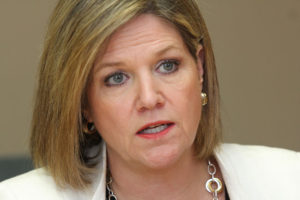 Andrea Horwath leader of the New Democratic party – will Burlington have an NDP candidate for 2018? Who? Horwath has complained about smart meters as well, and has mused about buying back Hydro One shares but has yet to release her full party platform. And if history is any judge the NDP policies will be a twist, a nuance, on the ones the Liberals already have borrowed form the NDP – or stolen as the NDP regularly accuse.
All of this seems to indicate a kind of humdrum, big yawn of an election muddle. It may all depend on how badly people want to change, how bored or unimpressed they are with the Liberals and their leader after a decade and a half, despite the good times. It would be naive to ignore the age and gender of leaders as factors voters consider, though style and campaign performance will probably be the final determinants. And of course the party stalwarts will be voting the party line.
 Ray Rivers writes weekly on both federal and provincial politics, applying his more than 25 years as a federal bureaucrat to his thinking. Rivers was a candidate for provincial office in Burlington in 1995. He was the founder of the Burlington citizen committee on sustainability at a time when climate warming was a hotly debated subject. Tweet @rayzrivers Ray Rivers writes weekly on both federal and provincial politics, applying his more than 25 years as a federal bureaucrat to his thinking. Rivers was a candidate for provincial office in Burlington in 1995. He was the founder of the Burlington citizen committee on sustainability at a time when climate warming was a hotly debated subject. Tweet @rayzrivers
Background links:
Forum Poll – Wynne – Horwath –
Ontario’s Cap and Trade – Cap and Trade vs Carbon Tax – Smart Meters –

 By Staff By Staff
December 29th, 2017
BURLINGTON, ON
It has been a couple of years since the city invited Brent Toderian into town to advise the city manager and the Director of Planning on the steps to take to turn Burlington into the city he thought everyone wanted it to be.
 Brent Toderian Toderian is beloved by much of the planning department – that sentiment didn’t manage to spread to the citizens of the city. On balance – views are mixed.
This is not an occasion to dig deep into the impact Toderian is having on the city but it is an opportunity to get a look at the thinking he does from time to time.
It might help to understand where some of the core thinking within transportation is coming from.

 By Ray Rivers By Ray Rivers
December 25th, 2017
MOUNTSBERG, ON
No discussion of the highlights of 2017 would be complete without mention of the Donald Trump effect. Despite great resistance by just about everyone, Trump has been largely successful in re-positioning the US globally and within. For example America has forever lost its time honoured reputation as the great global melting pot. Muslims and Latinos, in particular, are no longer welcome to Trump’s land of “America First”.
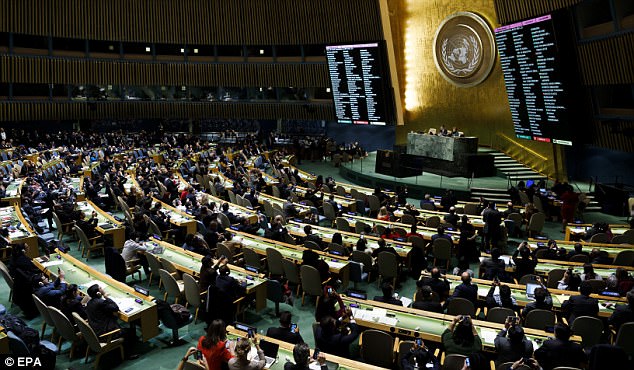 United Nations held emergency General Assembly session Thursday over Trump’s decision to recognize Jerusalem as Israel’s capital Member nations voted 128-9 with 35 abstentions on a resolution regretting ‘recent decisions concerning the status of Jerusalem. Canada abstained. By isolating itself from the rest of the world on issues including preserving the planet’s climate and Middle East politics, Trump’s America has been refreshingly liberating – unleashing former reliable partners which once looked to America for direction and leadership. Last week’s UN motion opposing Trumps’ decision to locate his embassy in Jerusalem was a case in point. Despite his administration’s threats to cut off aid to those voting for the motion, he lost overwhelmingly. Indeed his threats likely only served to mobilize many still sitting on the fence.
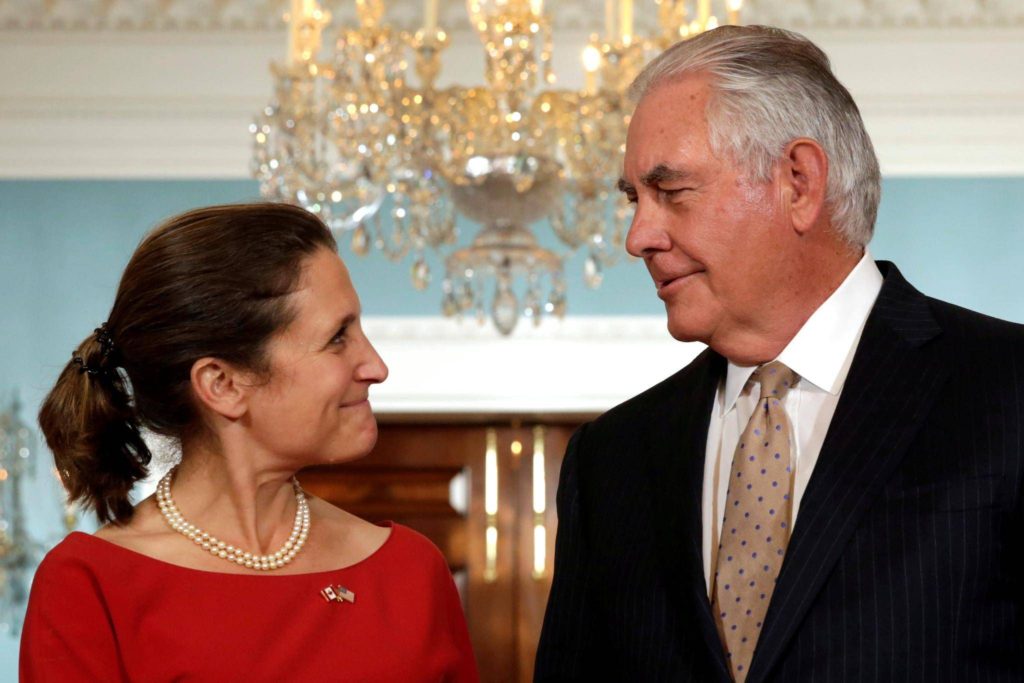 Minister of Global Affairs Chrystia” Freeland and US Secretary of State, Tillerson at a meeting in Ottawa last week. But Canada was not one of those. There is no question that Mr. Trudeau damaged his international rock star reputation, and may have lost us another chance to get on the Security Council, by abstaining. Earlier this week the US Secretary of State, Tillerson, flew up to Ottawa, presumably to make sure Canada toed the line and didn’t vote against its big neighbour.
One should wonder what price Canada charged for compromising our integrity and political independence. Perhaps Trump won’t be tearing up NAFTA after all now. But wait didn’t the US trade junta just reduce the countervail duties payable, on those Bombardier airplanes which Delta had purchased, from a whacking 299% down to a more reasonable 292%? Is that all we got – seven percentage points?
Trudeau breezed into office with almost impossible expectations and it should not be surprising that we’d be witnessing the inevitable climb down. Sure there was the dream, which became a broken promise, that he’d reform our system of governance to make it more representative. And then he stumbled on another promise, this time about tax reform.
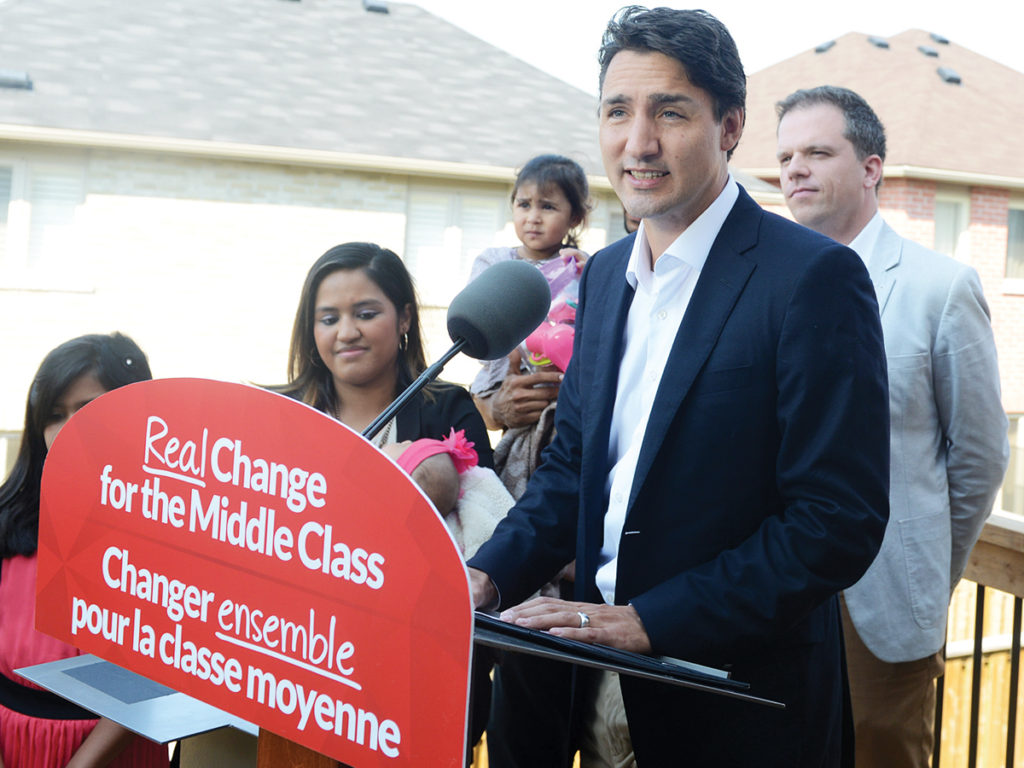 Liberal leader Justin Trudeau on the campaign trail promising real change for the middle class. Trudeau may genuinely be fighting for the middle class but nobody sees him as one of them. Everyone knows he has family money and rich friends living on tropical islands in the ocean somewhere. So targeting those who are actually middle class for tax avoidance by merely ‘income spreading’ – well no wonder he and his financially well-endowed finance minster ended up with bloody noses.
Chances are the PM’ll be staying home this Christmas after all the fuss over his last Christmas holiday with the Aga Khan. And besides he already got to play a generous and obviously confused Santa Claus this year, giving $10 million to a convicted terrorist – instead of that proverbial lump of coal for the naughty.
Still Canada’s economy is booming and even Alberta is bouncing back. In fact Alberta and Ontario are leading the country in growth. And much of that credit has to go to our federal government, and of course the lower Canadian dollar. Still trade issues threaten to cloud those big blue economic skies – NAFTA of course. And we’re without any possible trade deal with China. Mr. Trudeau apparently couldn’t get the right terms – better no deal than a bad one.
Mr. Trudeau has been rewarded for his stewardship of the economy by scoring two by-election converts, the most recent in B.C.. Though polling generally shows his party running pretty much neck-in-neck with the Tories and their new leader Andrew Scheer. But interestingly neither Scheer nor the NDP’s Mr. Singh got a bounce in the polls following their leadership victories.
 Canada is respected and listened to in the Middle East. We always live in interesting times and the next year will be particularly challenging for our federal government. For example, how do we respond when Mr. Trump offers us a new free trade pact, one without Mexico? Assuming war with North Korea is inevitable, would it be prudent or provocative to join the US in a continental anti-missile shield? Given our warm relations with Israel and the US what will be our position should they preemptively attack Iran, Syria and perhaps other middle-eastern nations?
Next week we’ll look at the provincial picture.
 Ray Rivers writes weekly on both federal and provincial politics, applying his more than 25 years as a federal bureaucrat to his thinking. Rivers was a candidate for provincial office in Burlington in 1995. He was the founder of the Burlington citizen committee on sustainability at a time when climate warming was a hotly debated subject. Tweet @rayzrivers Ray Rivers writes weekly on both federal and provincial politics, applying his more than 25 years as a federal bureaucrat to his thinking. Rivers was a candidate for provincial office in Burlington in 1995. He was the founder of the Burlington citizen committee on sustainability at a time when climate warming was a hotly debated subject. Tweet @rayzrivers
Background links:
Liberal Popularity – Trudeau’s Bahama Christmas – Khadr –

 By Pepper Parr By Pepper Parr
December 21st, 2017
BURLINGTON, ON
Every media document the city sends out and many of the reports that come out of city hall have the tag line:
Burlington is one of Canada’s best and most livable cities,
a place where people, nature and business thrive.
It’s the kind of thing George Orwell wrote about in “1984” – the rule seems to be that if you say it often enough it becomes true. Did the person at city hall who wrote the line believe it? It was probably done by a committee with the final version being signed off on by the city manager.
For those who rely on public transit there must be a very cruel irony –there will be no transit service on either Christmas Day or New Year’s Day.
The holiday transit schedule is set out below.

Salt with Pepper are the opinions of the Publisher of the Burlington Gazette.

 By Rory Nisan By Rory Nisan
December 21st, 2017
BURLINGTON, ON
There has been a disconcerting trend at city hall where language is being used as a tool to manufacture consent. The most concerning has been the use of the word “emerging”. This was used during the recent waterfront development consultations (emerging preferred concept), as well as in reference to the city’s official plan (emerging vision).
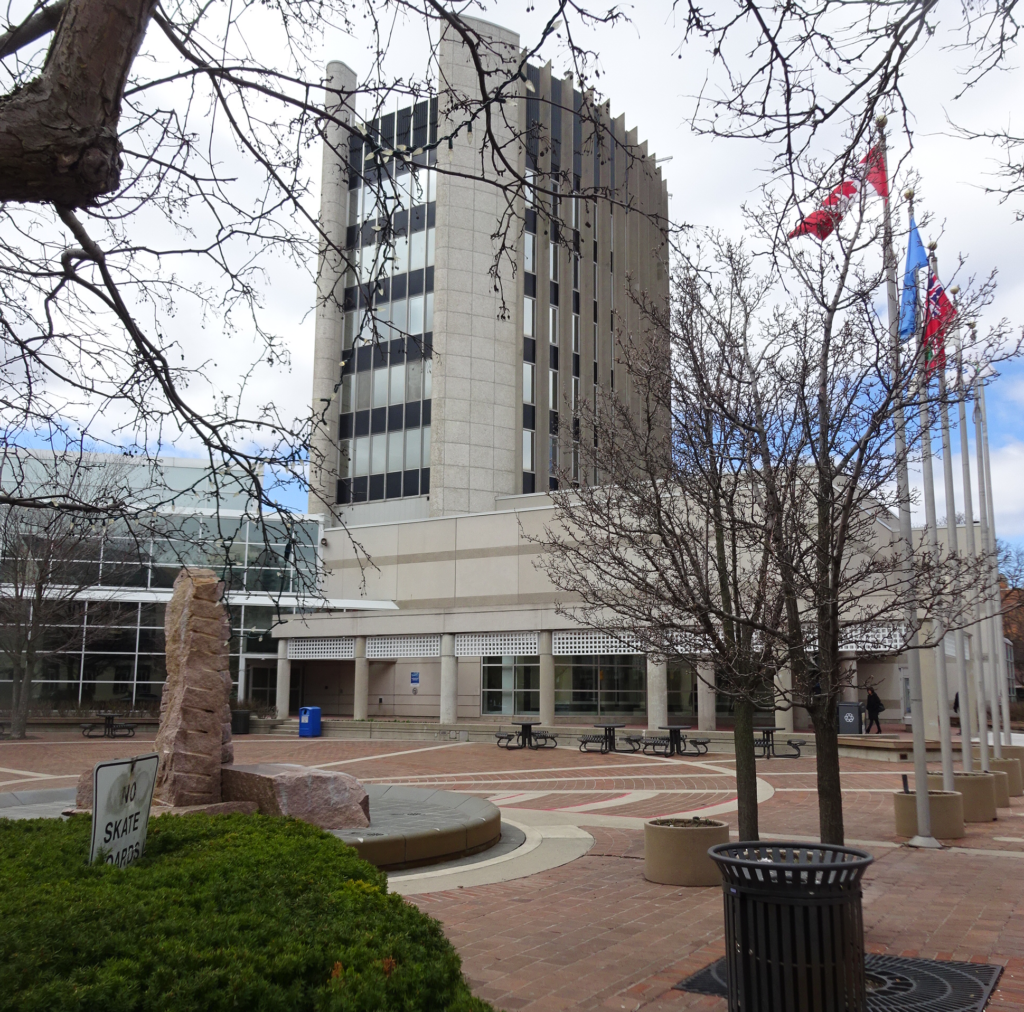 Can the democratic process flourish at city hall? What is wrong with emerging concepts and emerging visions? The problem is that neither has been voted on by the duly elected representatives of the city. Planning staff, or even the city manager cannot state that anything is “emerging” until it has been democratically decided. By doing so, they are undermining the all-important democratic process, and this can lead to citizens being led to believe that decisions have been made long before they have been.
Do city planners see themselves in the driver’s seat, with city Councillors and the mayor also in the car, and the city’s citizens running behind, trying to catch up?
To extend the metaphor, in a well-functioning democracy the elected representatives may be in the driver’s seat, but with citizens sitting shotgun, holding the map and able to pick new drivers at regular intervals.
Planning staff should promise city council not undermine democratic space by using misleading language regarding unapproved plans in the future.
Unfortunately, the lack of understanding of democratic principles in some offices of city hall extends to members of city council. Councillor Paul Sharman, in his recent blog post, made clear that he doesn’t understand a second fundamental principle of democracy: it is about much more than elections.
 Ward 5 Councillor Paul Sharman talked down to his constituents when he said, “The issues are quite complex.” Regarding 421-431 Brant street, Councillor Sharman could have demonstrated that he was listening to Burlingtonians and reflecting their concerns at city hall. Instead, Councillor Sharman talked down to his constituents when he said, “The issues are quite complex. Council was elected to understand all the issues and to figure how to address concerns of the entire population.”
Issues are complex. Water is wet.
It is impossible to address the concerns of “the entire population” because it is impossible to know the views of everyone in the city. Instead, council is expected to listen to constituents because those who speak up have the greatest investment in the issue at hand. Council must at a minimum balance those concerns with a broader perspective. One cannot simply dismiss concerns raised as not representing the entire population. Nor can one use “NIMBY” as a rhetorical device to put down anyone who does not want a high rise downtown on Brant street.
Councillor Dennison employed a similar argument in dismissing a petition with over 1000 signatures related to the development at 421-431 Brant, saying that he had to represent the views of all Burlingtonians, not 1000.
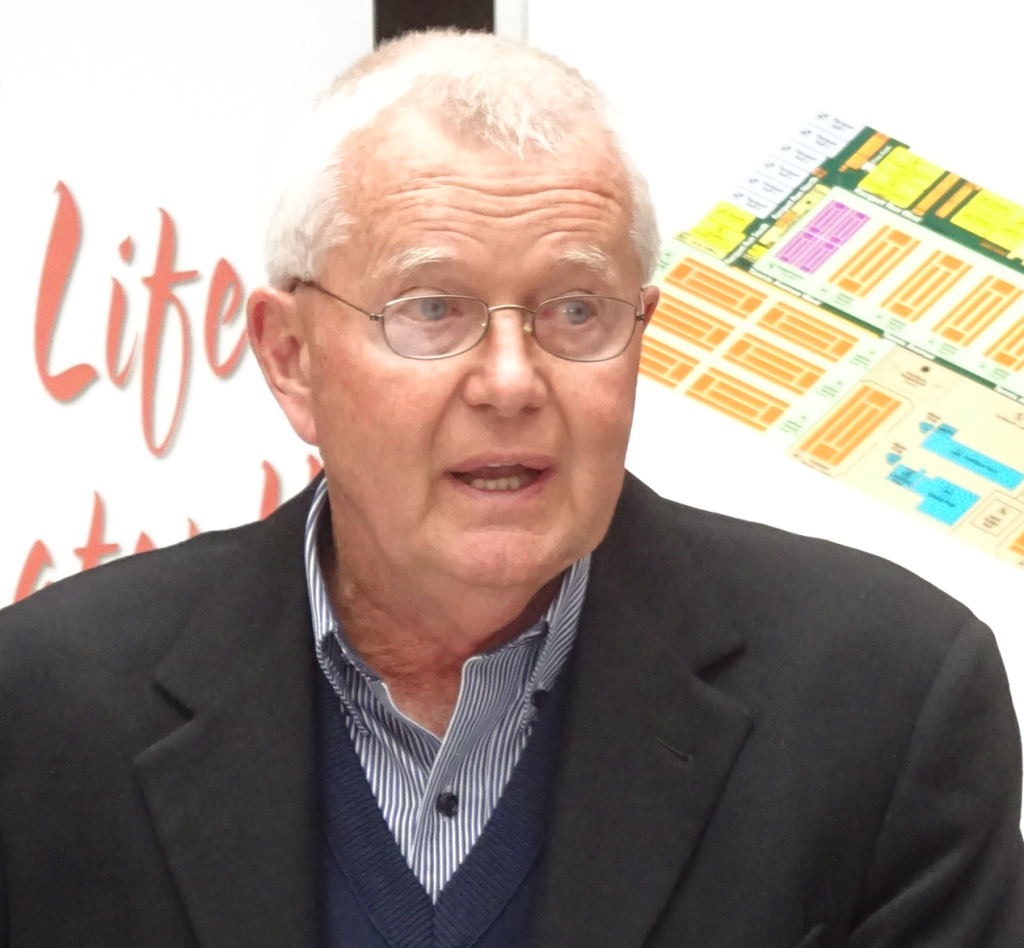 Ward 4 city Councillor Jack Dennison – has yet to see a citizen petition that cannot be dismissed easily. Petitions are at the core of democratic action, so important that they can be registered in parliaments around the world. They are a demonstration of whether social licence is given to politicians to proceed. They cannot be dismissed so easily. In this case, there is so little support for 421-431 Brant street – no petition in support of the project – yet strong opposition.
Councillor Sharman also lectured his constituents in a related Facebook post on the Official Plan, writing:
“What is generally not appreciated by community members is the city is sub organization [sic] of the province of Ontario, not an independent organization. The role of the City is to implement plans established by the province almost without question. It does require interpretation though, hence the official plan and all of the angst it is causing.”
This paragraph deserves a close look as it reveals how a Councillor approaches his job and the role of his constituents.
First, he makes a broad generalization of the community, presuming that we are unaware of the municipality’s position within the provincial government framework. Many of us are well aware that the municipality is part of the Province of Ontario – anyone who has even thought about the role of the Ontario Municipal Board recognizes that municipalities are not islands. So why lecture us?
Second, he says, “The role of the City is to implement plans established by the province almost without question.” I have not seen any provincial legislation that limits the ability of city councils to lobby the province for changes, to even demand changes to plans that it sees as inappropriate. Questioning, debating, requesting, suggesting, pleading and persuading are all actions that can be taken by municipalities when it sees plans that are contrary to the best interests of a city. Contrary to Councillor Sharman’s assertion, there is much give and take between municipalities and the province. It is unfortunate that Councillor Sharman appears to have ceded that role in favour of the ostrich approach.
Finally, Councillor Sharman reduces the legitimate concerns of constituents to “angst”, an emotional response, implying that the community is not thinking clearly, and would understand the real world if only they could put their feelings aside, be quiet and listen. He is blaming constituents for behaving foolishly and letting emotion cloud their judgement.
 When an elected leader does not listen to their constituents, they are not respecting their constituents. Leadership that believes it “knows best” has a deleterious effect on our democratic institutions. When an elected leader does not listen to their constituents, they are not respecting their constituents. Leadership that believes it “knows best” has a deleterious effect on our democratic institutions.
Politicians who do not understand the importance of social licence and of representing constituents throughout their terms must be taught that lesson at the polls, as it remains the strongest weapon of democracy.
 Rory Nisan is a long-time Burlington resident and Lester B. Pearson High School alumnus. He has been an active member of the Save Pearson community organization. Rory Nisan is a long-time Burlington resident and Lester B. Pearson High School alumnus. He has been an active member of the Save Pearson community organization.

 By Gary Scobie By Gary Scobie
December 19th, 2017
BURLINGTON, ON
I am a citizen who has taken an interest in issues at or near our waterfront and in the downtown core over the past seven years. I am concerned when I see attempts at over-intensification being made in Burlington, especially in our downtown core.
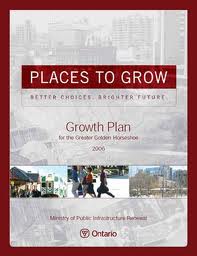
If we go back in time, it all started with the Provincial Places to Grow Act of 2005. This was the first attempt by the Province to control urban sprawl, preserve our Greenbelt for nature and agriculture and plan for better transit options in the Greater Toronto to Niagara area. The Growth Plan of 2006 followed, designating increased densities of population and jobs in most municipalities of Southern Ontario and calling these Urban Growth Centres.
Cities did have some say in these designations. For instance, Oakville decided not to intensify its downtown to Provincial targets, but rather to expand population and jobs dramatically around its GO Transit Station at Trafalgar Road. This would be its Urban Growth Centre. It would intensify its downtown using its own zoning rules in its Official Plan. It would intensify its downtown more gently than an Urban Growth Centre.
Burlington Council at the time appears to have bought into the idea of the Downtown Urban Growth Centre, as suggested by the Province. I can find no counter debate or decision to intensify around our GO Transit Stations instead of our downtown. This decision to go with the Provincial flow would lead nearly ten years later to where we are today – the rush to over-intensify the Brant Street corridor and nearby streets to the east and west under a new Official Plan.
Getting back to the past, Metrolinx was conceived in 2007, shortly after the Growth Plan was enacted. It was all about transportation across the regions to support intensified population and job centres.
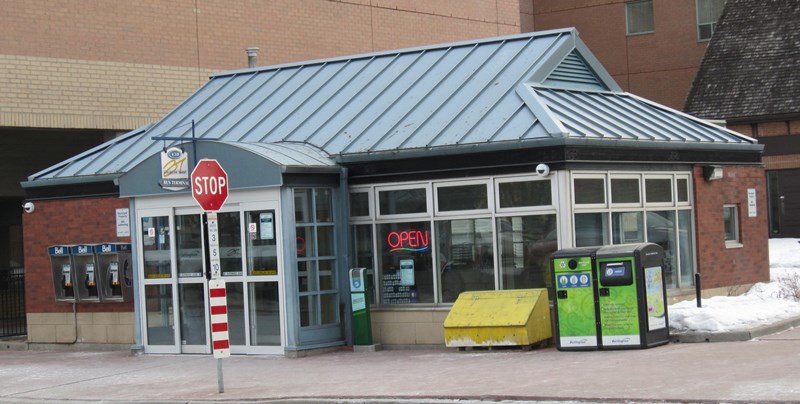 Less than three years ago the transit terminal was going to be torn down – now it appears to be the “anchor” for a mobility hub. It focused on the GO Transit network of stations for the most part, but also added in subway, light rail transit and bus rapid transit routes, established and suggested for the future, as connecting links to GO Stations to move people in the this large region, mostly to and from jobs. Hence the Big Move nomenclature that was attached.
Soon the term Mobility Hub would be added to the vernacular in 2008. These were supposed to support Urban Growth Centres by linking them through the transit networks of municipalities and GO services. They were originally supposed to be locations where a number of modes of transportation came together as a network to facilitate the movement of people easily between these modes.
 The Burlington GO station – an obvious location for a mobility hub. GO Stations would all naturally qualify as Mobility Hubs because they link car, train, City and GO bus, bicycle and pedestrian modes of travel together in one place, with parking provided at no extra cost. Only recently have I seen the designation of Anchor Mobility Hub used to describe those Urban Growth Centre hubs that fail to qualify as true Mobility Hubs. The Burlington Downtown Mobility Hub is one of those Anchors. It has no trains, no light rail transit or rapid bus transit. And it has no free parking for cars.
It seems that Urban Growth Centres and Mobility Hubs have been linked together for quite a long time, dating back to 2008. This linkage is not accidental. It seems that to be an Urban Growth Centre, you had to have or plan for a Mobility Hub and vice versa.
These linkages were known to municipalities since 2008 and some decided, like Oakville, to chart their own course and preserve their downtowns from over-development by accepting the Urban Growth Centre/Mobility premise, but set in places best suited to dramatic infill of high rise condos and some retail and office space. GO Station locales were the obvious choice in this case.
In Burlington’s case, as stated before, it appears that no disagreement with the Province’s suggested choices for a downtown Urban Growth Centre/Mobility Hub ever arose in City Council meetings. The Province chose our downtown as both and our Council at the time (somewhere in 2008 – 2010) accepted, possibly without public debate. Council may have thought that the downtown needed improvement and this pathway, as mandated by the Province, was as good a way to get it done as any “made in Burlington” solution. And the Province could always be blamed if it didn’t work out quite right. I should note that one of our GO Stations, Burlington GO Station, was designated a Mobility Hub by Metrolinx (ie. the Province) and also accepted by Council.
There is a private, non-partisan charitable foundation known as the Neptis Foundation (www.neptis.org) that researches and reports on regional growth plans and initiatives. It has done some excellent reports on the Growth Plan and Urban Growth Centres that describe in layman’s language the Province’s plans and the repercussions to Ontario municipalities starting with 2006 people/job densities and projecting the changes required for 2031 densities. I would invite you to check out their reports.
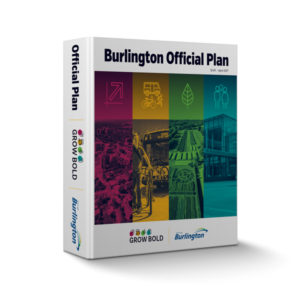 Many want the Mobility Hubs kept out of the Official Plan. Some municipalities have integrated the Province’s growth plans into their Official Plans in major ways. Burlington is one of these municipalities. Other municipalities have done less or even no integration. There is no prize from the Province that I can detect for doing so, nor any penalty thus far for ignoring the Province.
The Ontario Government reviewed the 2006 Growth Plan in 2016 and reported in July 2017 a revised Growth Plan going all the way to 2041. It can be found at www.placestogrow.ca.
It should be noted that right from the beginning, expectations for each municipality were “directing growth to major transit station areas”, “identifies priority transit corridors”, “complete detailed planning for major transit station areas on these corridors to support planned service levels”, “plan for a range and mix of housing, including second units and affordable housing” and “accommodate a range of household sizes”.
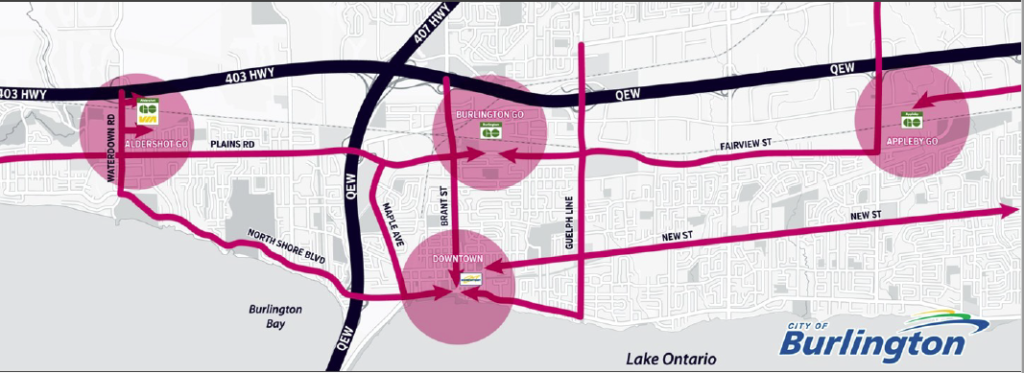 Having Mobility hubs at the GO stations is something everyone agrees on – it is the idea of a Mobility Hub in the downtown core that has many opposed. How is Burlington doing in these initiatives? Well, all three GO Stations in the City have been named Mobility Hubs and each are planned to house many thousands of people/jobs by 2031. So growth is being directed to our major transit stations. Will there be any affordable housing and accommodation of a range of household sizes? That’s an unanswered question thus far.
I thought that Burlington was mandated to grow to a population of 215,000 by 2031. I have since been informed the target is 185,000 minimum. We are at 183,000 now. Recently at a Planning and Development Committee meeting, the Ward 1 Councillor stated publicly that Aldershot was set to grow by another 27,000 people by 2031. This would likely be near the Aldershot GO Station or along the Plains Road Corridor. Adding another 11,000 jobs there would bring the additional people/jobs total to 38,000 by 2031 and a 300 people/jobs per hectare goal, as per a Planning Department report dated Nov. 9, 2017.
Similarly, Planning Department reports also dated Nov. 9, 2017 for the other GO Stations show the Burlington GO Station Mobility Hub adding 22,000 new residents and 9,500 jobs by 2031 and the Appleby GO Station Mobility Hub adding 20,000 new residents and 43,000 new jobs by 2031. Both would also reach the 300 people/jobs per hectare goal.
All together, the three GO Station Mobility Hubs are planned to add 69,000 new residents to Burlington’s population by 2031, far exceeding any goal of 185,000 or even 215,000. We’re headed to a quarter million people by 2031, without touching the downtown.
So it is clear to me that we can reach all Provincial goals easily using intensification of people and jobs at the GO Station Mobility Hubs. There is no need to further intensify the downtown at all. It could be left to gently intensify, like Oakville has planned, using current Official Plan zoning rather than dramatically intensify as the Planning Department has advocated in its new Downtown Mobility Hub Plan and the new City Official Plan.
Anchor Mobility Hubs were originally expected to support an area with a minimum of 160 people/jobs per hectare within a 500 metre radius that would be serviced by a light rail transit or a bus rapid transit system.
The City is using a 200 people/jobs per hectare goal, which may be the revised mandate. I understand that City Planners and most of City Council are backing the people/jobs density downtown, but I see no evidence that there is an LRT or BRT system in place to deal with this influx of people/jobs, other than an LRT label being affixed to Brant Street on maps. A label isn’t a plan unfortunately.
I also see no evidence that jobs will flow into the downtown, even to just replace the ones lost when current buildings are demolished awaiting construction of new buildings. The podium style high rises with 3 to 4 storey glass and steel walls along Brant Street will replace individual and unique store frontages we have today. Is this better or worse at enticing jobs and vibrancy to Brant Street?
I am a person who believes that a deal is never a done deal if there is still an opportunity to question and possibly change people’s minds for the better of the community. And I think that we do have that opportunity.
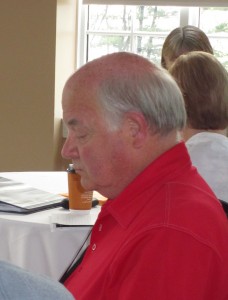 John Taylor, the Dean of city council would have been part of any debate there might have been about accepting the provincial approach to mobility hubs. 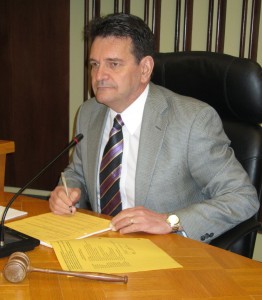 Ward 1 Councillor Rick Craven – a member of council in between 2008 and 2010 when Scobie believes city council made the decision to follow the provincial lead. Four members of the current Council were members of Council when all these Provincial demands were rubber-stamped. I would ask them to search their memory banks and their notes and inform the public how they decided to acquiesce to the Province’s demands for intensifying our downtown, why they didn’t make the logical suggestion for intensification around GO Stations instead and if they did go ahead with the plans without public consultation.
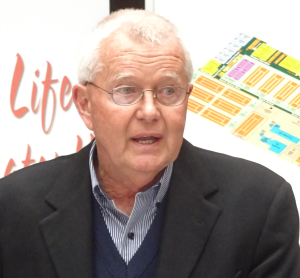 Jack Dennison, a member of city council for more than 20 years would remember how the decision to accept the provincial direction – somewhere between 2008 and 2010 was made. 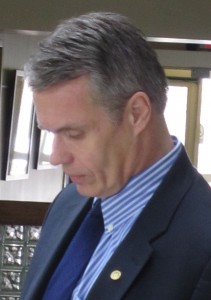 Mayor Rick Goldring was a council member when the decision was made to accept the province’s approach to transportation hubs, possibly without public debate. The current Council certainly did not acquiesce to the 374 Martha Street proposed high rise a few years ago. Yet this same Council voted 5 – 2 in favour of a 23 storey condo on November 30, 2017 across the road from our 8 storey signature City Hall – going past the 12 storey current storey zoning and even going past the recommended 17 storey zoning in a Downtown Mobility Hub Plan not yet approved.
This decision has ignited public opinion against the over-intensification of the downtown. They see high rises coming on many corners of Brant Street, and with many mid-rise condos in between. And they see many high buildings destined to come on nearby north-south streets east and west of Brant Street.
During the Vietnam War an infamous sentence was uttered by a field commander which showed the absurdity of war – “We had to destroy the village in order to save it”. Brant Street and our downtown does not need to be destroyed in order to save it.
Gently intensifying the downtown will continue as it has in the past, using appropriate zoning already in place. City planners and City Council need only enforce our current Official Plan and use the concepts already in place in our Tall Building Guidelines and soon to be in place in our Mid Rise Building Guidelines that the Planning Department has committed to.
Our downtown Bus Station is not a Mobility Hub and there is no plan to make it one. Our downtown does not need to be over-intensified through a designation as an Urban Growth Centre. I am asking City Council to inform the Province that Burlington can and will meet its 2031 growth target through dramatic intensification around our three GO Stations, the appropriate place for high rise condos with retail and office space.
That’s where the thousands of new residents will be housed, hopefully with a good number of affordable, family-sized units.
The downtown will intensify too, but not in the dramatic fashion envisioned by the Planning Department.
I am asking City Council to request that the terms Mobility Hub and Urban Growth Centre be removed from the Provincial Growth Plan for the Downtown Precincts and instead be placed on all three GO Stations.
Let our downtown, which admittedly does need to change, do so in a measured and controlled fashion that adheres to reasonable and defendable zoning restrictions already in place. Do not follow through on an Official Plan that would create the “Metropolis” of Halton in our downtown.
 Gary Scobie, a long time resident of Burlington is a frequent opinion contributor to the Gazette. He was a member of the Waterfront Advisory Committee and has been a strong advocate for maintaining public access to the waterfront. Gary Scobie, a long time resident of Burlington is a frequent opinion contributor to the Gazette. He was a member of the Waterfront Advisory Committee and has been a strong advocate for maintaining public access to the waterfront.

 By Ray Rivers By Ray Rivers
December 18, 2017
BURLINGTON, ON
This is the second of a two part series on affordable housing and the changes made by the federal government.
After he retires, which is not anytime soon, Justin Trudeau will be eternally remembered for giving us legit whacky-tobacky. But he will also have performed one of the largest re-distributions of income this country has seen. And that is not just about the modest changes his government made to the income tax structure, favouring the middle class, his first year in office.
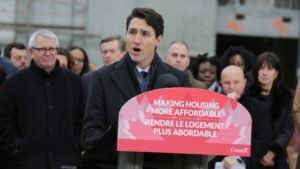 No it’s the $40 billion dollar ten year affordable housing strategy which is to kick in sometime after the next election, providing the provinces kick in their shares as well. The details are scarce but putting that much money in the hands of people who are finding it hard to get affordable accommodation will be a huge economic stimulus for the country. No it’s the $40 billion dollar ten year affordable housing strategy which is to kick in sometime after the next election, providing the provinces kick in their shares as well. The details are scarce but putting that much money in the hands of people who are finding it hard to get affordable accommodation will be a huge economic stimulus for the country.
That may be prudent given where Canada may be in its business cycle, particularly if NAFTA hits the dust bin, as I expect it will. It may also stimulate home building and urban restoration as rental units and high rise condo’s come to fill the gap between demand and supply of housing for Ontario’s growing population. But if the economy keeps moving the way it has under the Liberals, it could also lead to inflation.
 Perhaps that is why Trudeau is delaying the start up until 2020. Cynics will note that this is also an early 2019 election promise. But after the run-up in house prices recently nobody should argue that there is a problem with affordability, certainly for single homes. And as house prices go, so too must go rental costs eventually. Perhaps that is why Trudeau is delaying the start up until 2020. Cynics will note that this is also an early 2019 election promise. But after the run-up in house prices recently nobody should argue that there is a problem with affordability, certainly for single homes. And as house prices go, so too must go rental costs eventually.
There was a time when owning a home was everybody’s dream, but those days appear to have come to an end. Two thirds of Canadians still own their own home but that is changing as the cost of home ownership continues to rise. The average price of a home in Canada has topped half a million, despite a cooling-off in the Toronto and Vancouver markets.
Given that average household income are around $70,000 (2015), it would take at least seven or eight years for a new home buyer to pay off their mortgage – providing they used all of their gross income to that end – and lived on water and hope. Practically, those who own their own homes spend less than 20% of their income on housing. Of course that statistic would be higher except that many have already paid off their mortgages and only face costs for maintenance and property taxes.
 Offered at $789,900 – estimated monthly mortgage $2891.00 Still given those numbers it would take the average homeowner up to 40 years to pay off their mortgage unless they inherited a bundle, won the lottery or got a federal handout along the lines of what Mr. Trudeau may be talking about. Otherwise a thirty year-young couple might be 70 by the time they paid off the banks – just in time for one of those reverse mortgages to free up some cash so they could spend the winter in a rented trailer in Florida.
Renters, who typically are lower income earners, shell out 30% of their pay packet for a roof over their heads by contrast. That represents a bigger bite out of a smaller pay packet and they will undoubtedly be the primary target for the new affordability strategy. Chances are dim that they’ll ever get into the ownership market. Spending 40 or even 20 years before one can burn that mortgage paper is a long time.
There are financial advisors who argue that it would be better for one’s financial health to rent and let them invest that cash that would otherwise be plowed into a house. They say this with a straight face, even knowing that a primary residence is capital gains tax-exempt. They ague that history shows a house’s value will just keep up with inflation while they can do much better with somebody else’s money in stocks and bonds. And perhaps they can though there was a lot of money made buying and selling Toronto and Vancouver houses, just recently.
But this federal-provincial affordability program is not going to do much for those who already can afford their homes – it presumably will only target those in need. Early indications are that priority will be to encourage new developments which also meet other development goals at all levels. Narrowing the income gap between rich and poor, stimulating the economy, facilitating urban renewal and mitigating climate change is a pretty tall order for any program. Mr. Trudeau called this initiative a once-in-a-generation event. And if he can pull it off he will leave a lasting legacy for his generation.
 Ray Rivers writes weekly on both federal and provincial politics, applying his more than 25 years as a federal bureaucrat to his thinking. Rivers was a candidate for provincial office in Burlington in 1995. He was the founder of the Burlington citizen committee on sustainability at a time when climate warming was a hotly debated subject. Tweet @rayzrivers Ray Rivers writes weekly on both federal and provincial politics, applying his more than 25 years as a federal bureaucrat to his thinking. Rivers was a candidate for provincial office in Burlington in 1995. He was the founder of the Burlington citizen committee on sustainability at a time when climate warming was a hotly debated subject. Tweet @rayzrivers
Background links:
Canadian House Prices – Average Household Income – Home Ownership –
Changing Home Ownership – Recent Renting Changes – Housing Stock –
Affordable Housing – Housing Bubble – Bad Policy –
Federal Plans – Public Housing – Home Ownership –
House as Investment – More Investment –
Related editorial content:
Part 1 of the Affordable housing feature

 By Keith Moorse By Keith Moorse
December 16th, 2017
BURLINGTON, ON
I was shocked to learn of the approval by council of Amendment No.106 allowing the construction of a 23 story condo at 421Brant St. This is almost twice the existing bylaw of 12 stories. Just as disappointing was the lack of any explanation by the five Councillors for approving the application. I have not heard a single voice supporting the project ,save and except the Planning and Building Department’s 112 page report submitted to the Planning and Development Committee.
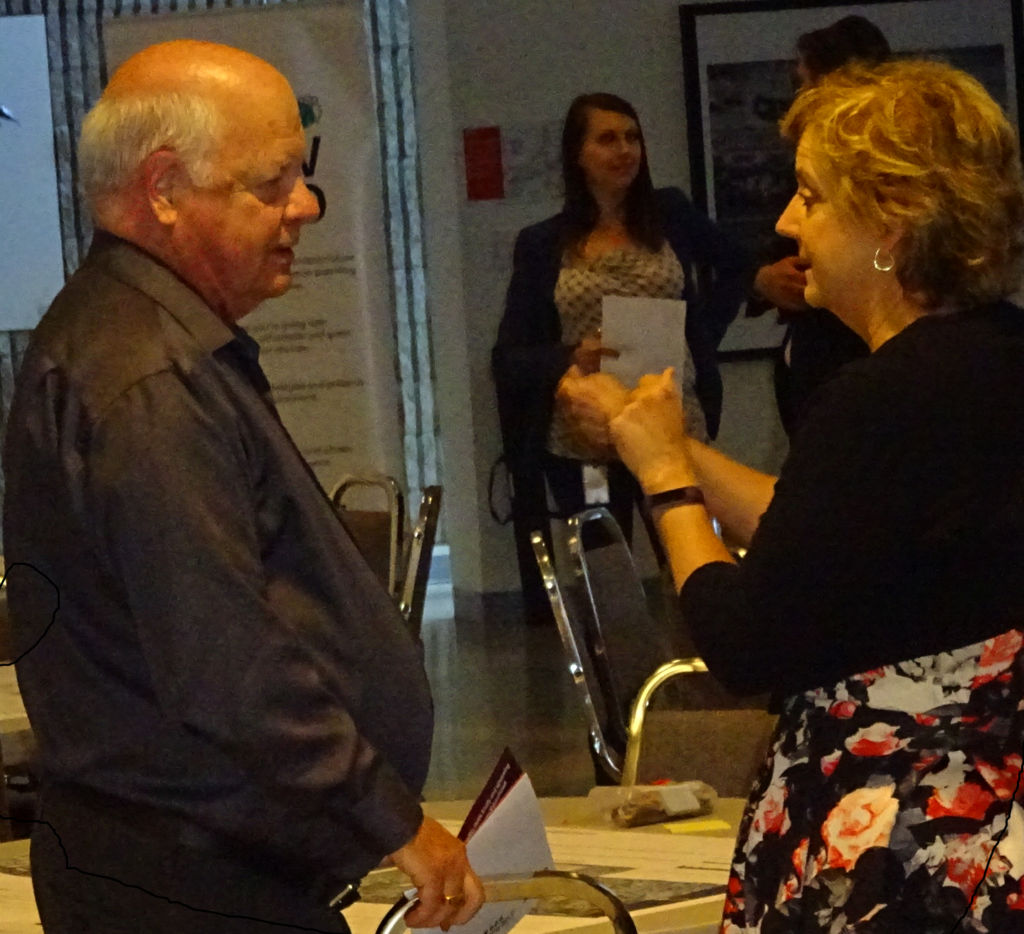 City Planner Mary Lou Tanner explains a development to ward 3 Councillor John Taylor The role of the Planning and Building Department also needs clarification. Who do they represent? Their report reads like it was drafted by the developer with the recommendation based on unreasonable assumptions, out right contradictions, false conclusions, and serious omissions.
What can be done to cancel the approval of Amendment 106 and implementation of this project?
FIRSTLY: Restore the democratic process whereby the citizens opinions and input receives consideration. If the five councilors truly represented their constituents they should welcome the opportunity to demonstrate their commitment.
SECONDLY: Establish a referendum process to allow the citizens to determine the outcome of the project and Amendment #106.
THIRDLY: A thorough review of the report (PB- 62-17) by The Planning and Building Department and revisions made where necessary.
If this development takes place it will totally and permanently change the character and charm of lower Brant Street and the City of Burlington. This will affect all residents and is too big a decision for Burlington Council alone. A precedent will be established and more applications will follow, as is already anticipated. There is a reference in the report, PB-62-17, that the proposed 23 story building will look less obtrusive when similar buildings are erected in the immediate area. This is an admission that this building will look out of place until others are erected.
The Burlington Sustainable Development Committee has added it’s comments to the application, starting on page 149. It sets out several conditions to be met, most of which have at best received only lip service. For example: “full public participation in development decisions”. Input was given at public meetings and to council, however, it was ignored. It also called for the new development to be compatible to existing end users, which is clearly not the case. Putting aside, all the disputes regarding whether or not, the analysis is flawed the issue really distills down to three distinct choices:
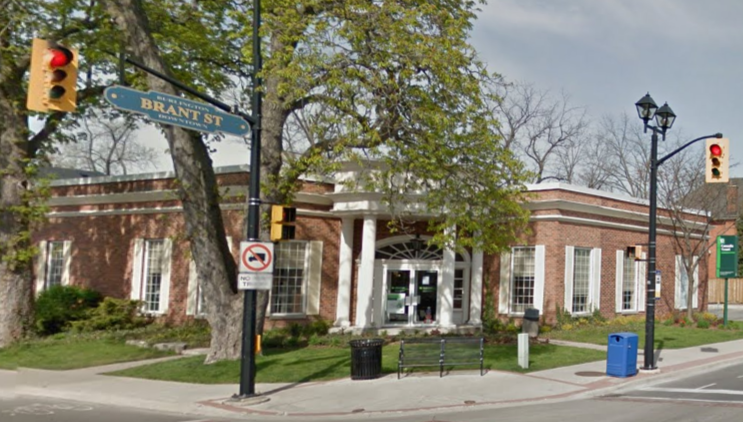 Part of the “quaint” small town Burlington feel that many citizens want. 1.Reject the by-law Amendment No.106 to allow a 23 story condo at 421 Brant Street, keeping lower Brant Street with its’ boutique like shops, and eateries. It has a quaint friendly character which has contributed to its rating as the #1 City of its’ size in Canada in which to live.
2.Allow the amendment to pass thus creating the tallest building in Burlington changing the character of Brant Street and Burlington itself. It would become a Mississauga or Toronto with its’ not so charming steel and glass canyons.
3.Authorize a 12 story building as established by the new official plan.
There are other locations where such a building would be more suitable. Just leave our historical Brant Street alone.
Appendix “A”
1. New Official Plan (NOP) states tall buildings in the downtown area should exclude construction of same on Brant Street which is presently approved for 12 stories.
2. Many units will be three(3) bedrooms to attract families yet elsewhere in the report it states the target market as being “ affluent empty nesters”.
3. Parking at 1.2 spaces per unit hardly meets the requirement for the family ( 3+ adults).
4. Two elevators to service 23 floors are inadequate
5. This project in NOT needed to meet the Provincial Growth Plan minimum target (report PB-62-17).
6. This is not an isolated project and sets a dangerous precedent.
7. Why 23 stories, when there are many exciting designs far more appealing which could be achieved in 12 stories? The cold sharp angles of this structure does not compliment City Hall. Burlington can do better.
8. The only one benefiting from 23 stories is the developer.
9. Years of disrupted traffic due to construction, making a bad parking/traffic situation worse.
 The clock plaza at City Hall provides this focus. 10. Many small businesses on lower Brant may not survive due to prolonged construction activity.
11. Burlington does not need a “signature’ building. The clock plaza at City Hall provides this focus.
12. For what purpose are there height By-Laws when they are continuously waved?
13. Staff response to citizens’ concerns with building height is flawed. They compare other buildings which cannot be considered in the same category the tallest being 5 floors lower(18) then the applicant and 2 to 3 blocks East of Brant. None are in fact on Brant Street.
14. No infrastructure costs are allocated to the City of Burlington for the sewer and water expansion and upgrades.
Keith Moorse is a Ward 3 resident. He is a retired senior executive with a Bay Street merchant bank with national responsibility. He has been a resident of Burlington since 1981

 By Pepper Parr By Pepper Parr
December 15th, 2017
BURLINGTON, ON
There are almost as many views on what Burlington should be doing in terms of its growth as there are people in the city.
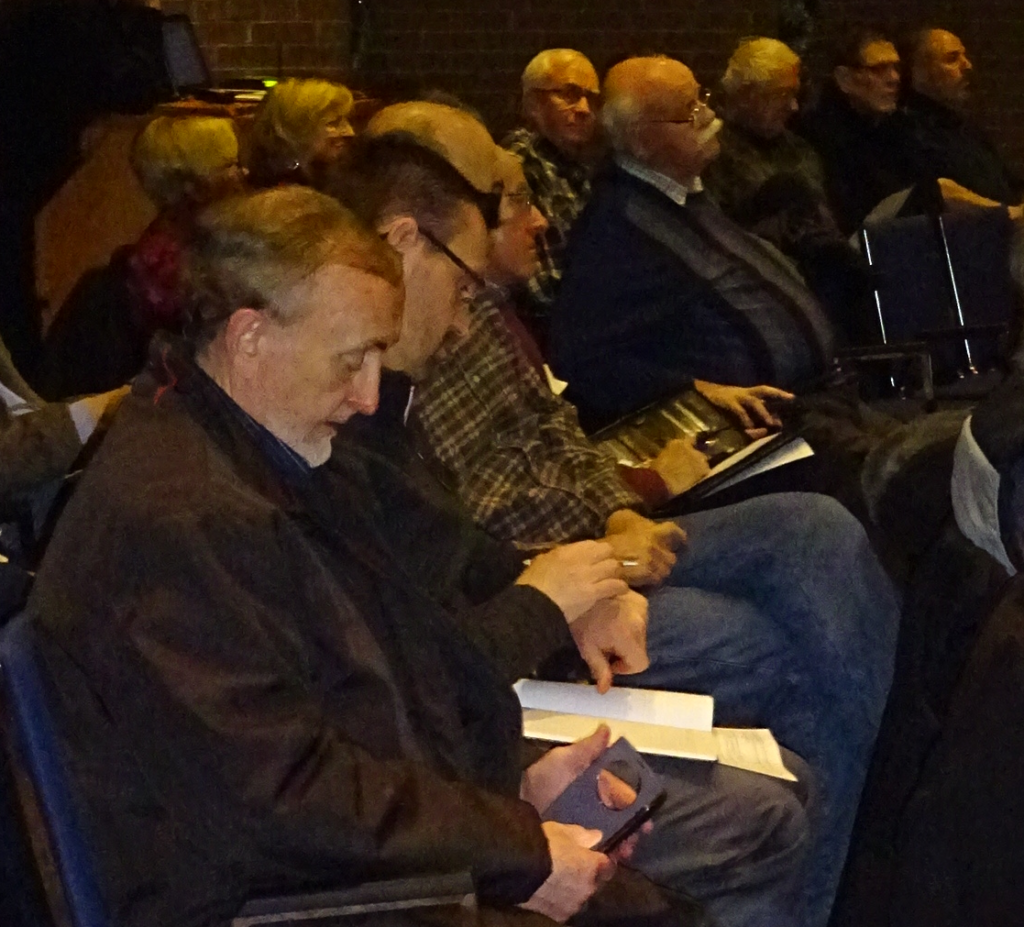 Citizens listening to the concerns community groups have over how developments in their neighbourhoods are handled by the Planning Department. The meeting was organized by the Engaged Citizens of Burlington – ECoB When Lisa Kearns, one of the ECoB organizers, stood at the lectern in the Burlington Baptist Church she told the 150+ audience that they had to do their homework and then hoisted a three in loose-leaf binder up and told the audience the information they need is out there – but you do have to work to find it and then offered to share what she had with anyone interested. We didn’t see anyone asking to borrow the binder.
Many of the people involved in what is a complex subject are reluctant to identify themselves publicly. One of those wrote in and said: “Seems that this group is questioning the “Urban Growth Centre” designation in Downtown Burlington. The answer is really, really simple – all people have to do is go back to and look at the original Places to Grow document from 2006 – Schedule 2. The designation is right there. No municipal approval is required. The Province says “this is it” now “do it”. All of this talk about evidentiary materials is a complete waste of time.

“People must also consider “The Big Move” which designates the mobility hub in the downtown as an “Anchor Mobility Hub”. Anchor Mobility Hubs are focal points with the potential to transform urban structure and improve transit. In other words … big changes are expected.
“There is an Appendix B which indicates that the downtown mobility hub is expected to accommodate 2,900 boarding per day. The question should be “why is the City not planning for this?” not is it really a hub.
“This same Appendix B includes a population target for the downtown anchor hub of greater than 25,000 people and jobs by 2031. The City is not even close to being able to accommodate this target.
“Most importantly, some people selectively ignore the fact that City Council unanimously approved its Strategic Plan that identifies the downtown as an area where intensification and redevelopment is to be directed.”

Joe Gaetan, a frequent contributor to the Gazette explains that the 2017 Growth Plan for the Greater Golden Horseshoe, was prepared and approved under the Places to Grow Act, 2005 to take effect on July 1, 2017.
Section 2, entitled, Where and How to Grow, contains S, 2.2 Policies for Where and How to Grow, and S 2.2.3 entitled, Urban Growth Centres and contains the following:
“Urban growth centres will be planned to achieve, by 2031 or earlier, a minimum density target of:
b)400 residents and jobs combined per hectare for each of the urban growth centres in the City of Toronto;
200 residents and jobs combined per hectare for each of the Downtown Brampton, Downtown Burlington, Downtown Hamilton, Downtown Milton, Markham Centre, Downtown Mississauga, Newmarket Centre, Midtown Oakville, Downtown Oshawa, Downtown Pickering, Richmond Hill Centre/Langstaff Gateway, Vaughan Metropolitan Centre, Downtown Kitchener, and Uptown Waterloo urban growth centres;”
Oakville took an approach that attached more importance to Employment and Commerce. Their Livable Oakville committee produced a very detailed report – something Burlington might want t56o at least review.
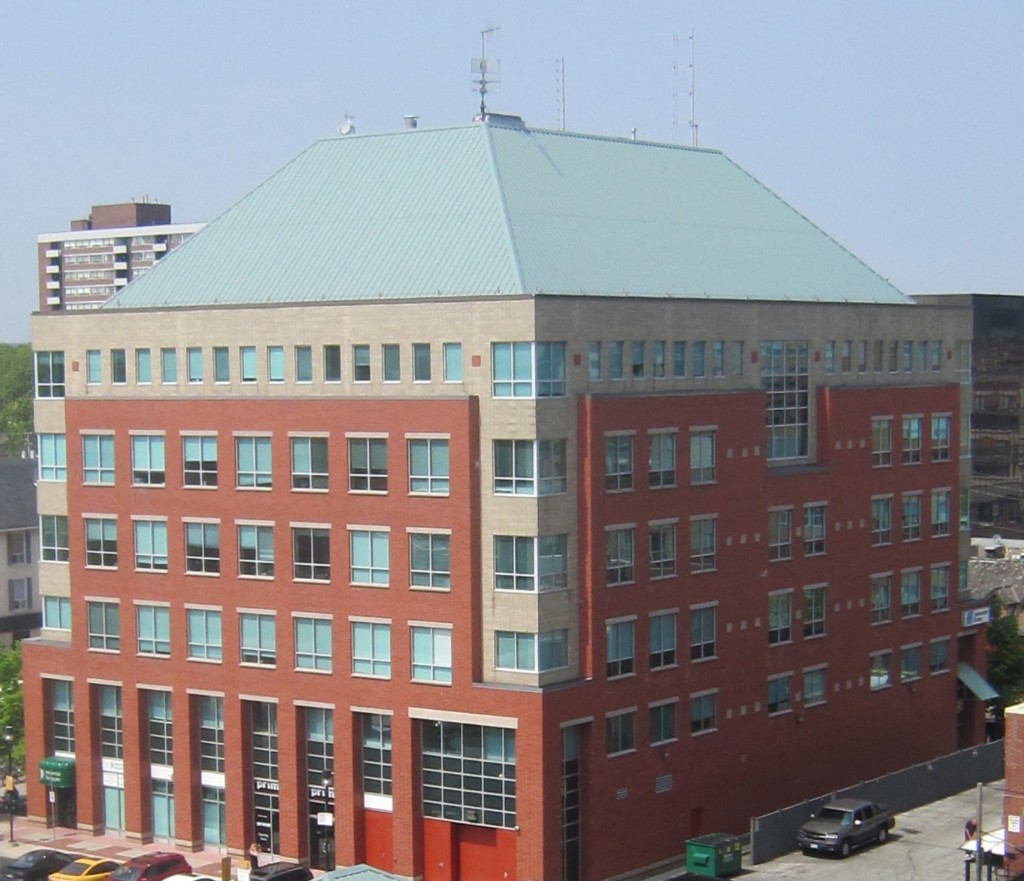 The Sims building across from city hall is the only office building in the core of the city – the city of Burlington is the largest tenant. Burlington has never succeeded in attracting commercial operations into the downtown core – parking space wasn’t possible – thus the major concentrations of corporate offices are along the north and south corridors.
“The Burlington Official Plan appears to be mostly silent on job creation or preservation of work land or spaces.
“This should be a concern to all and one more reason why our Official Plan process must be stopped in its tracks.”
Background material:
Where to download a copy of the Places to Grow legislation.
The Big Move – what it is and where to get a copy of the document.

 By Pepper Parr By Pepper Parr
December 15th, 2017
BURLINGTON, ON
We received the following this morning:
The article published in this morning’s Gazette titled “Major organizational moves by the city manager seem to be out of focus” is wholly inaccurate for the following reasons:
Parks & Recreation has NOT been merged into Roads, Parks & Forestry (RPF). Parks & Recreation continues to be a separate department headed by Chris Glenn
There has been no reorganization undertaken by the city manager, except the creation of a deputy city manager position and changes to department names only.
Council was fully briefed and aware of the creation of a deputy city manager position, to say so otherwise in incorrect.
Mary Lou Tanner will continue to lead the Official Plan and the Mobility Hub initiatives as deputy city manager; a competition to hire a new Director of Planning will begin in January.
Ms Tanner’s appointment as the deputy city manager was in no way a demotion and as previously stated was a result of a comprehensive internal competition
On November 9th, the City Manager, James Ridge announced a renaming of departments at city hall and moving responsibilities into the newly named departments under the people who were to head them up.
The renaming of the departments in the city was to more accurately reflect the services that are provided to residents.
 As of Jan. 1, 2018 Roads and Parks Maintenance will become the Roads, Parks and Forestry Department; with Mary Battaglia as lead. As of Jan. 1, 2018 Roads and Parks Maintenance will become the Roads, Parks and Forestry Department; with Mary Battaglia as lead.
Planning and Building will become the Department of City Building – Planning, Building and Culture with Mary Lou Tanner as lead.
Then on December 9th, Ridge announced that he had appointed Mary Lou Tanner as the deputy city manager after a comprehensive internal competition.
There is something about this picture that is out of focus.
If it was a “comprehensive internal competition”, and we will take the city manager’s word that it was – the competition had to be announced, those wanting to go after the job had to prepare their application, fine tune it, submit it and then let the Director of Human Resources and the City Manager review what they had.
The Director of Human Resources may well have been one of the applicants for the new position; we will let that slide.
 Newly minted Deputy City Manager Mary Lou Tanner Re-org November 9th, Tanner made deputy city manager December 9th – All this got done in less than a month?
What does the appointing of Tanner as Deputy City Manager do to the absolutely critical work being done on the planning side?
As of the 21st of this month the city doesn’t have a Planner. Tanner, the woman who was doing the job is now the “city’s representative for all Agencies, Boards and Commissions; acting in an advisory and liaison capacity for each organization and helping plan and coordinate major capital projects.”
Not much in the way of executive authority there
“Being responsible for the diversity and inclusivity portfolio; ensuring a strategy is developed, and implemented across the organization for all services and programs.”
Important but not the same level of influence as the Director of Planning
“Overseeing the Project Management Office, ensuring the priorities of this office are aligned with the Strategic Plan and corporate work plans and work with the Senior Leadership team to identify and establish priorities across the organization.”
 City Manager James Ridge – now has a Deputy to aid the important work he does, Tanner was a part of the Senior Leadership Team – now she “works with them”. Will Tanner have any clout? Will she be making decisions or does everything she does slide up to the desk of the City Manager?
There is going to be a “transition plan including an acting Director of City Building will be announced in the near future; however in the meantime Tanner will continue to lead the work on the completion of the city’s new Official Plan.”
How much of this were the city Councillors fully aware of? The City Manager is responsible for the administration of all city staff and serves at the pleasure of city council. Is Council pleased?
The time line for the approval of the Official Plan has been stretched out to April of 2018 from the original end of January 2018 date.
None of this looks very encouraging – we are changing horses in the middle of a fast flowing stream.
Troubling.
 Director of Parks and Recreation Chris Glenn There some additional concerns. Parks and Recreation is now merged in intro Roads Parks and Forestry under the direction of Mary Battaglia who is a Director. She now has Chris Glenn, also a Director working under her?
Transportation doesn’t seem to have a home at a time when there are several significant studies being done on just how people are going to get around the city given all the intensification that is to take place.
Where does Capital Works fit into the new organization?
On Friday, the 8th of December we had occasion to be at the Fire department following up part on a news story and met with a deputy fire chief who advised us that the Fire Chief was still on the site of the blaze that shut down the Paletta operation in the south-east of the city.
That’s where a Fire Chief is supposed to be – where the problems are. The fire was basically out – with some hot spots that needed a close watch to ensure that they didn’t flare up.
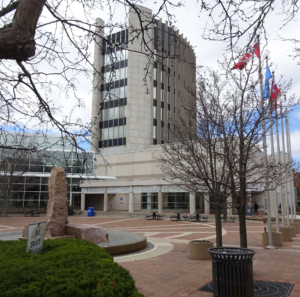 Is the apparent senior staff reorganization a good one or is it a picture out of focus. The city has a problem – getting the new Official Plan in place and helping the citizens understand the mobility hubs. It is seen as a “hot spot” to hundreds of informed and involved people in Burlington. This is not a time to have senior staff fully immersed in the work they are in place to do.
Being made Deputy City Manager doesn’t look like a promotion – looks like the City Manager just got someone out of the way
And that is very troubling.
Links to related news stories:
Appointment of Deputy city manager.
Renaming of city departments.

 By Pepper Parr By Pepper Parr
December 14th, 2017
BURLINGTON, ON
Is there a sea change taking place in Burlington politics?
Last week there was a neighborhood meeting in Aldershot about a proposal for a 6 story condo at 92 Plains Rd, right on the edge of a long established Aldershot neighborhood.
 Some at the meeting felt it was “totally out of compliance with the existing Official Plan and bylaws” and was being promoted as “in alignment with city proposals for the Mobility Hub.” Some at the meeting felt it was “totally out of compliance with the existing Official Plan and bylaws” and was being promoted as “in alignment with city proposals for the Mobility Hub.”
It was a raucous meeting. Nobody was happy, and many expressed this clearly and often angrily.
The discussion was on the negative impact on nearby property values from a development which Councillor Craven supported.
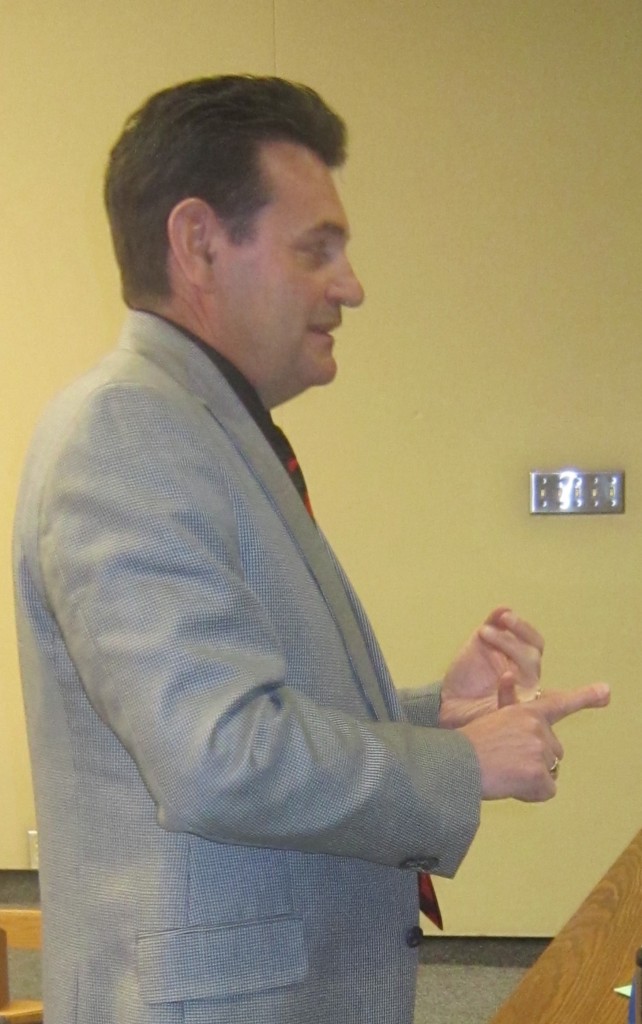 Ward 1 Councillor Rick Craven faced a hostile audience while explaining the justification of a development. This photograph was not from that meeting. Craven got called out a couple of times for not showing any support to residents, and for trying to undercut their concerns.
The city planner in charge threatened to shut the meeting down if the rancor and heckling that ensued was not stopped.
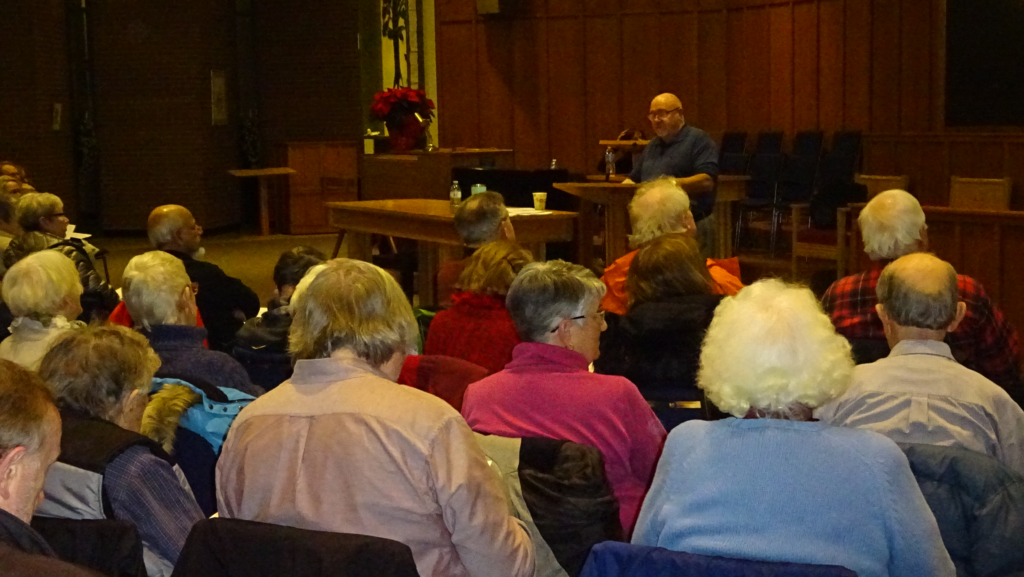 When a resident stood up and said “We need to tell the members of council that we are not going to vote for them” there was an immediate robust burst of applause – they were sending a message – loudly and clearly. The recently formed ECoB – Engaged Citizens of Burlington – meeting that took place Wednesday evening had representation from every ward in the city – people were just not happy with the way decisions were being made. They want change in the way city council decides on very complex issues.
The focus at the Wednesday ECoB meeting was a development that didn’t get any negative comment when it was introduced to the public several months ago at the Art Gallery. There was just the one delegation when the development was put on the table at a Standing Committee – but when council voted 5-2 for the development – the dam of feelings burst.
People didn’t want their city changed – they continually refer to a vibrant downtown core when Brant Street is anything but except when the Santa Claus parade and the Sound of Music Festival fills the streets.
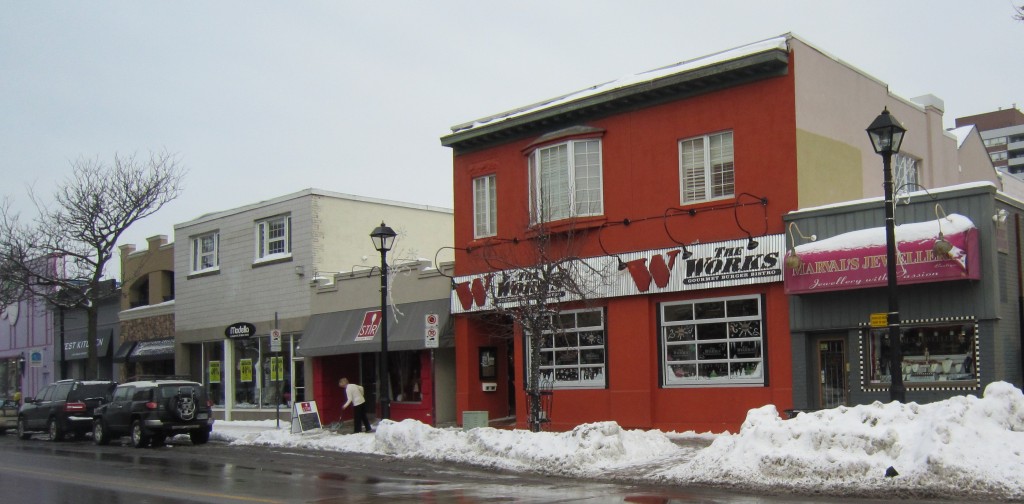 East side of Brant Street several days before Christmas 2013. It isn’t all that different this year. Not what one would call festive. Anyone who strolls along Brant street might be taken aback at how little there is in the way of Christmas decoration on the buildings.
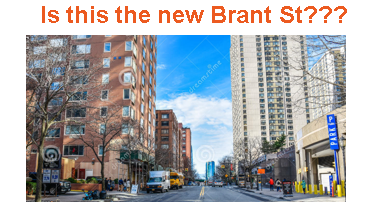 This graphic was put up on a screen at the Wednesday ECoB meeting. The city keeps saying this kind of thing is not going to happen – the citizens no longer believe them. There appears to be a hankering for a time when things were slower, more certain, safer.
Every politician now faces citizens who are unhappy.
That unhappiness is now being pulled together by a group of citizens who don’t like what they see and tend to exaggerate to make their points.
Interesting times ahead.

 By Staff By Staff
December 13th, 2017
BURLINGTON, ON
In his regular newsletter to his constituents Ward 5 Councillor Paul Sharman sets out why he was one of the five Councillors who voted for the 421 Brant Street development to proceed.
 Ward 5 Councillor Paul Sharman. I admit that I was one of the 5 (out of 7) members of Council who voted in favour of accepting staff recommendations to build a 23-storey building on the 421 Brant Street site, opposite City Hall. This decision was despite a significant effort by a number of residents, including an online petition with about 1,400 names, to persuade members to vote against the recommendations. The residents’ primary concerns appeared primarily to focus on the number of floors and “over intensification”. They said the building is too high. A number of residents said they simply want to keep Brant street the way it is.
Certainly, the issue of height appears to be a concern to some proportion of Burlington residents. Of course, we all love our family friendly, low key, community. So, it is understandable. Yet a discussion that focuses on one location and on one measure (i.e. height) without giving sufficient consideration to other important and complex matters will cause much long term, serious problems in the City that Council is focused on trying to address.
First, I will address the application and why I supported the Council decision.
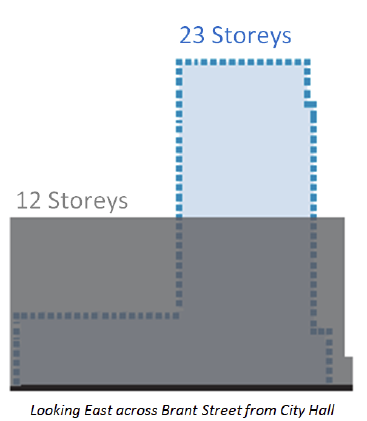 Massing with 12 storeys and massing with 23 storeys. Sharman and the developer saw the 23 storey version the better of the two. The site is permitted to have 12 stories by right. In other words, they could have proceeded without Council being asked to approve an amendment. Indeed, the owner did create plans to do so, however, City planning professionals were concerned a12 storey rectangular whole block sized building would be both unsightly and cause an unacceptable contribution to the downtown design.
• Clearly, the owners had a right to build something new on the site that would be larger in scale.
• Clearly, the City had created a plan to encourage redevelopment of the site with something new and large.
Staff had to negotiate with developers over what design characteristics would be acceptable. Clearly height is one such concern, but there are others. These include “massing”, set-backs, shadowing, parking, design and others.
In the case of 421 Brant Street, the developer had been working towards filing an application for many years. During that time, the Province had identified downtown Burlington, along with a number of other areas of the City, as a place for significant population density. This was a requirement from the Province, not a suggestion. Accordingly, the developer prepared an application for a 27-storey building that they believed would satisfy that requirement.
As is required, the developer consulted staff about their plans. Staff gave considerable thought to what the best design would be for the building and spent much effort over the last six months negotiating changes to the proposal that they believed would satisfy Provincial requirements, as well as many other considerations including many key issues presented by the public. The result was that they calculated the number of square feet of residential space that would have been allowed in the 12-storey block building and redistributed the floor space in a design that has a smaller street level foot print, with a four storey “podium”, on top of which they then proposed a 19-storey “slender” tower.
 East side of Brant Street several days before Christmas 2013. Wasn’t particularly festive looking. This design would satisfy all legal requirements. It also meant the developer was required to reduce the total amount of floor space in the building by 25%, part of which meant including less commercial and less retail space in the first four floors. Through public engagement, staff was presented with 10 issues that were their priorities (car share, wider sidewalks, separate visitor parking etc.). Of the 10, the approved design achieves 9. Staff negotiated with the developer to get these 9 priorities incorporated into the design.
Finally, the residents’ discussion became a debate about personal preferences and opinions about how something might look without taking into account all the other considerations. Everyone is entitled to their opinion, and in the end, someone had to figure out what to do. That was the role of the developer and City staff. Council agreed the recommendations were, on balance, a reasonable compromise. A compromise that we believe will withstand any test at the OMB.
Second, I will address how the application fits within the long term broader concerns of the City:
The extensive analysis that went in to creating the economic vision for the City and the Strategic Plan which received unanimous approval of all City Council has led to the creation of a New Official Plan, Downtown Precinct Plan. The biggest issue is the fact that the City is pretty much built-out which means that land values will continue to increase faster than elsewhere in much of Ontario. Burlington home prices increased 73% in the last 4 years.
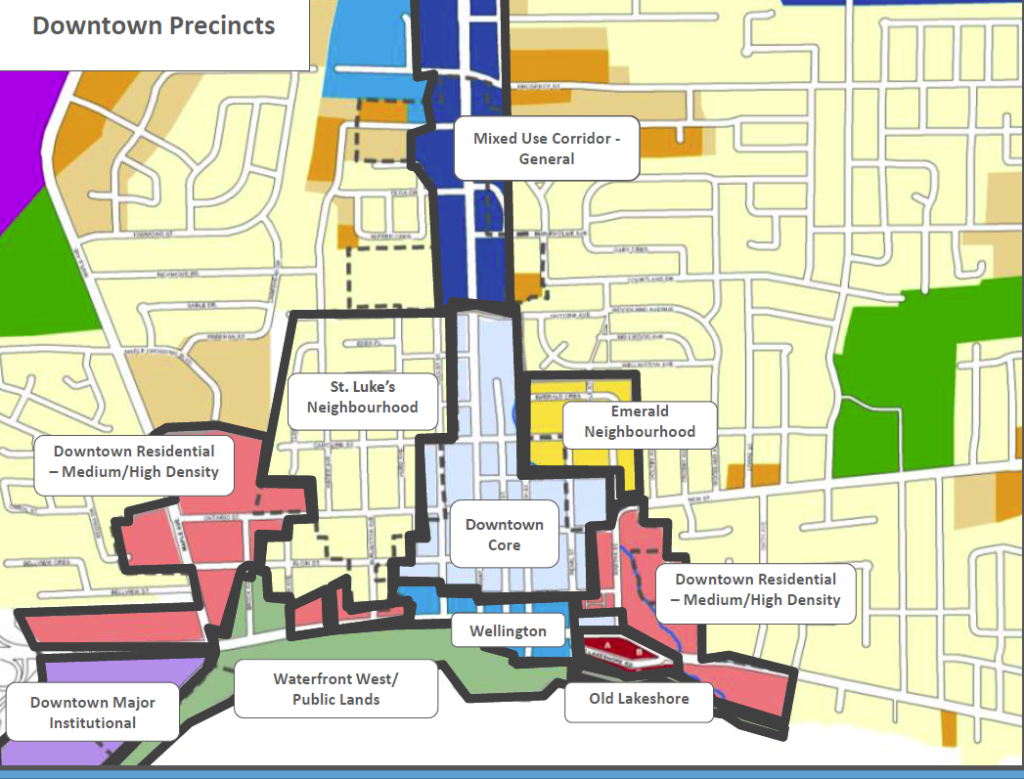 The Downtown area precincts. The only way that the City can provide housing that is substantially more affordable is by making better use of land, which means going up in certain places. The community is rapidly getting older. 20% of Burlington population is older than 65, that will double in the next 20 years and the number of people over 80 will quadruple. Many of us will want to sell our single-family homes to live in a lower cost condominium or rental building with less maintenance. If there is no more intensified form buildings here then people will have to move out of the area. The same is true for many of our young people. Just to make matters more interesting, as the community gets older there will be less people who live in Burlington available to work here. This means that it is likely businesses will move elsewhere. Businesses pay twice the rate of property tax as residential homes. If the amount of business tax paid to the city declines then residential property taxes will go up, and you already know how people living on a fixed income will react to that. Our goal is to increase the availability of housing for the young and old that they can afford without losing control of property taxes.
Alternatively, if the City attracts more younger people to live here then a) businesses can stay and grow, and b) homes for young people will also be subject to property tax, all of which means that there will be less pressure to increase property taxes rates as fast.
The plan is to allow only 5% of Burlington land to increase in density, most of which will be less than 11 floors and that will be along Fairview St., Plains Rd. and some areas around plazas. There will be more height around Go Stations. Only 11% of the downtown area will have more height, but not all sites along Brant Street, only a few. Most of the Brant Street height will occur close to Burlington GO. Even that will not be anything like Toronto or Mississauga where 50 floors is common. We expect the maximum to be in line with the buildings at Burlington GO station which are more like 25.
Under the New Official Plan, developers will not be permitted to assemble properties in single family home neighbourhoods in-order-to build tall buildings. Most areas of the City will keep the same type of housing that presently exists. It may be reviewed though.
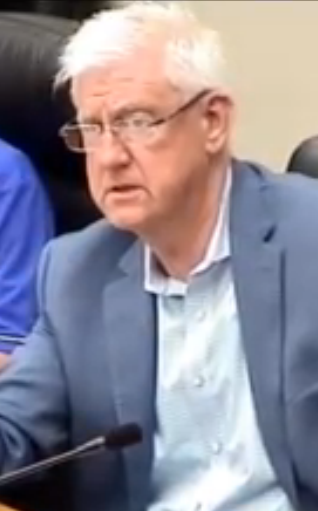 Councillor Sharman disagrees with those who don’t want height opposite city hall. The reasoning of City Planning staff and Council members at the committee meeting can be viewed on the webcast. Regular Meeting of Council – November 13.
The issues are quite complex. Council was elected to understand all the issues and to figure how to address concerns of the entire population. Some people think the precise number of floors in a building is more important than everything. I disagree.
Paul Sharman was first elected in 2010 and reelected in 2014. He was part of the Shape Burlington Committee. In 2010 he originally filed nomination papers to run for Mayor; when Rick Goldring filed his nomination papers for Mayor Sharman decided to run for the council seat Goldring held.

 By Jeremy Skinner By Jeremy Skinner
December 11th, 2017
BURLINGTON, ON
Where is the 421-431 Brant Street development application going?
If anyone has any concerns as to the City of Burlington’s decision with regards to the 421-431 Brandt St. application, then I suggest that they read the City of Burlington Planning Department’s Recommendation Report PB-62-17 which was accepted by City Council decision on November 13th.
The document in its entirety (all 71 pages) is at
Scroll down to Recommendation report and click on the report. The Recommendation report is close to the bottom – they don’t make it easy to find.
Upon reading the Recommendation Report, it is my opinion that the applicant (421 Brandt Street Inc.) and City Planning were unable to agree upon what the permitted height for the proposed building should be. I can only surmise that the developer threatened to seek an appeal to the OMB to obtain what could not be negotiated from City Planning Staff. A building height of twenty-seven storeys.
I base my opinion on the words “recommending modified approval” which are found in the Recommendation Report’s Subject line and two statements contained within the report found in the Section entitled “Purpose” documenting the different points of view. They are:
1. “The applicants are proposing to amend the Official Plan (Downtown Core designation) and Zoning By-law (DC zone) to permit the proposed 27-storey mixed use building with a floor area ratio of 10.29: 1.” and
2. “Notwithstanding, planning staff have recommended a “modified approval” which would permit a mixed use building with a height up to 23 storeys, subject to significant design and public realm improvements.”
While the developer has documented their agreement to comply with many City and Region comments made during the application process by submitting a revised application last August, the requested building height remained unchanged at 27 storeys.
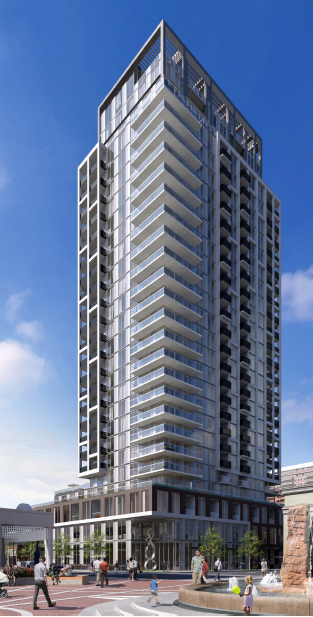 Skinner believes the developer has an important decision to make. In addition, the cover letter for the revised submission written by Mr. Mark G. Bales of 421 Brandt Street Inc. dated 03 August to Ms. Mary Lou Tanner Director of Planning & Building includes the following Conclusion statement: “Further to the comments received, the analysis completed by our consultant team and our comments above, we are requesting that you consider the resubmission materials and move the project forward to City Council for approval immediately.”
It is my opinion that the consequence of City Council’s approval on the 13th of November of the City Planning recommendations implies that the developer must decide between:
1. Complying with City Council’s approval of City Planning recommendation of “a mixed use building with a height up to 23 storeys, subject to significant design and public realm improvements.”
The City is not known to amend the Official Plan (Downtown Core designation) and Zoning By-law (DC zone) to permit development of the site until such time when it receives the developer’s agreement to comply.
Other parties, such as a Resident’s Association, can not seek an appeal to the OMB against the City and/or the developer until the City amends the Zoning By-law.
Should any of these other parties seek an appeal against the City and the developer, they would have to: prove that they made a delegation at the Statutory Meeting held on the first of November; assume the costs of obtaining suitable representation at the OMB; and make the case to the OMB that the City and/or the Developer made significant errors in interpreting Provincial, Regional and/or Municipal Policies, Principles and Guidelines.
The risk in seeking an appeal is that the OMB is an independent tribunal with the authority to approve, change, or reuse planning applications. As such all parties run the risk that the developer will take advantage of the appeal to make the case for the original development application requirements, including the 27 storey building height.
 Graphic profile of the proposed development on Brant Street – 12 storeys and 23 storey’s. The OMB may or may not ultimately side with the party seeking appeal in whole, or in part, based upon the strength of the arguments presented by all the parties for and against the appeal.
2. Appealing City Council’s approval of City Planning’s recommendations to the OMB in the hopes that the OMB will direct the City to “amend the Official Plan (Downtown Core designation) and Zoning By-law (DC zone) to permit the proposed 27-storey mixed use building with a floor area ratio of 10.29: 1.”
The costs to the developer in doing so include the costs of obtaining suitable representation at the OMB and the costs associated with delaying development of the property for between 6 and 12 months pending the OMB decision after multiple hearings.
The risk to the City is that the OMB is an independent tribunal with the authority to approve, change, or refuse planning applications. In other words, OMB decisions take the place of decisions made by Council.
The risk to the developer is that other parties, such as a Resident’s Association who made a delegation at the Statutory meeting held on the first of November, could make the case to promote more restrictive terms than those which were recommended by City Planning, such as to limit the building height to twelve stories, etc.
The OMB may or may not ultimately side with the developer in whole or in part of the appeal based upon the strength of the arguments presented by all the parties for and against the appeal.
It is my opinion that the decision rests with the developer as to where the 421-431 Brandt St. development application is going. Until the developer decides, no one else can and the development remains stalled.
Editor’s note: ECoB – Engaged Citizens of Burlington have called a public meeting for December 13th at the Baptist Church on New Street to discuss an appeal to the OMB of the city council decision to approve the the 421 Brant Street development.
Related content:
Staff recommendation.
 Jeremy Skinner is a Burlington resident who is a frequent contributor to the opinion pages of the Gazette. Jeremy Skinner is a Burlington resident who is a frequent contributor to the opinion pages of the Gazette.

 By Ray Rivers By Ray Rivers
December 11th, 2017
BURLINGTON, ON
This is one of a several part series on affordable housing
Over the 20th century the world’s population grew by 400 percent despite two world wars which killed off tens of millions of young people of child rearing age. Canada ranks 2nd in the planet by land mass but only 38th by population. Still we have multiplied from seven million in the early 1900’s to five times that number today.
Statistics Canada is projecting that we’ll be fifty or sixty million by the middle of the century. The post-war baby boom and the baby boom echo have been a big part of our growth. But that has now concluded as Canada, like other developed nations, has seen its natural birth rate plummet, for all but our indigenous communities.
 Immigrants who landed in Canada and came through Pier 21, which is now a museum. This country was built on the backs of these people – they are us? We are a nation of immigrants, including our first nations whose numbers were devastated by smallpox and other imported diseases introduced by the European settlers. Over the last decade Canada had welcomed roughly 250,000 migrants a year. More recent immigration plans will bumped these numbers to the point where we’ll be taking in a million more people over the next three years. And of course there is ongoing pressure to admit more refugees.
So even if we don’t actually have more children to take our places there will still be increased demand for housing. And most of those immigrants will be moving to cities in southern Ontario, Alberta, BC or Quebec, where housing markets are already relatively tight pushing up the demand and therefore the price of housing. Still, demographics is only one factor in this equation when it come to housing demand and supply.
Land use and fiscal (tax and government spending) policies also play a role. After all for most people their home is their biggest investment, and yet capital gains on that investment is tax-exempt, making ownership very desirable. A second or third home can also be a good source of rental income, in addition to being an appreciable asset.
 Everything north of Dundas and the 407 is rural – no development except in the hamlets; Kilbride, Lowville. The housing growth will have to be south of the dividing line. BC and Ontario recently introduced special taxes on non-resident owned property, a policy which has been credited with discouraging speculation and cooling down their steamy housing markets – at least for now. Some municipalities are considering additional taxes on vacant homes in order to encourage landlords to better utilize the existing housing stock. And then there is the impact of Air B&B, influencing house market dynamics – the conversion of long term to short term rental units adding new challenges to rental markets.
Developers and the real estate sector decry the constraints on land development, such as they see with the provincial Green Belt. Their biggest complaint is that this impacts there ability to convert cheap farm land into masses of single family homes, traditionally the most sought after type of housing, but also the least efficient. Why grow food when it so much more profitable to grow houses.
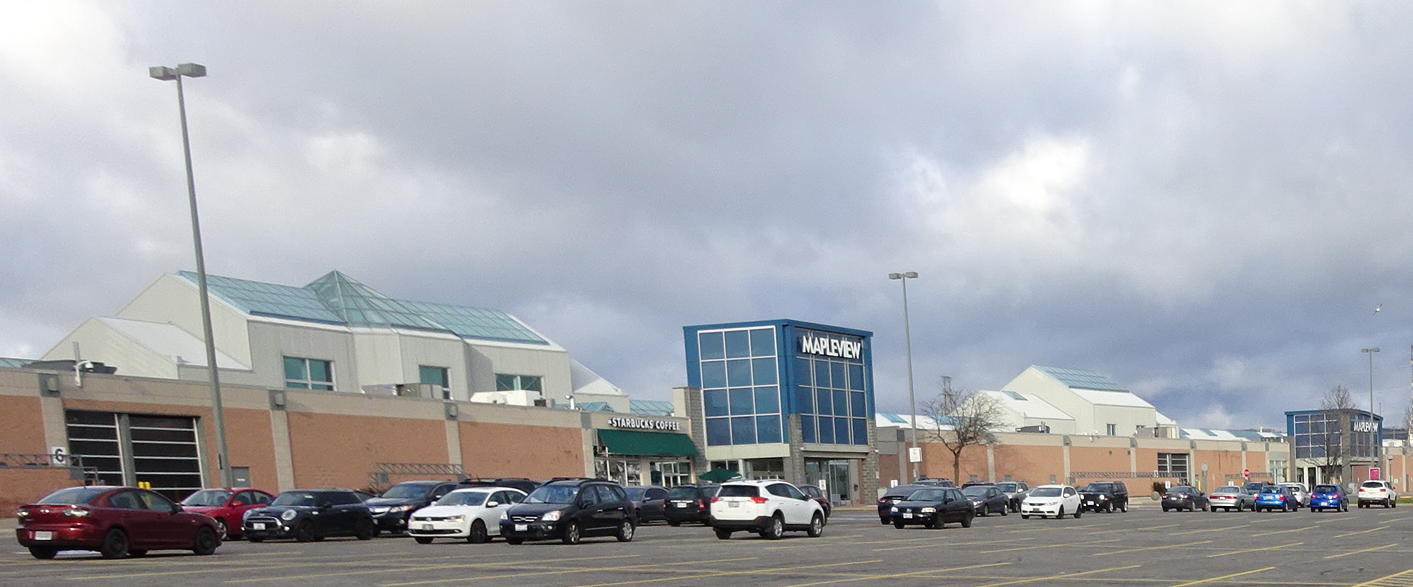 Once some of the best farm land in the province. “…they paved paradise and put up a parking lot.” Burlington was once home to some of the best farm land in Ontario. Nothing epitomizes its unfortunate transition to today’s urban form more than Mapleview Mall – where maple trees are no more. Indeed this development gives real meaning to Joni Mitchell’s song ‘Big Yellow Taxi’ – they paved paradise and put up a parking lot. It symptomatic of the demise of low growth rustbelt cities like Detroit, Cleveland and Hamilton at one time or another.
Highly touted GO commuter service is of little use if your job is scattered among the scads of low density industrial sprawl areas throughout the GTA. Spending up to half of one’s working day just commuting is crazy! And then there is the cost of that transportation, a huge price to pay for living the old ‘50s California suburban dream.
So the provincial planning whiz kids dreamt up this ‘places to grow’ stuff which municipalities treat as license to continue sprawl under another name. And of course developers love it. Because they can now make even more money than before building higher density homes on that same old cheap farmland, and occasionally tearing down low rise apartments to reach for the sky.
And there is the matter of municipal zoning policy. Originally designed to protect Dick and Jane in their comfy split-level from the horrors of industrial pollution, zoning has become the true enemy of sustainable living, creating silos in our cities which can only be broached by the automobile.
One only has to look at the parking lot at Mapleview during the Christmas season to get the point or Costco anytime. Strip malls, big box stores and shopping plazas have replaced the local corner store for much of what we buy. And nobody walks to get there. More recently on-lines sales and home delivery, à la Amazon, are threatening to re-shape the future of the shopping mall as consumers literally take to heart that old jingle – ‘let your fingers do the walking’.
Hong Kong has been called the best city for commuters with extensive public transportation options and one of the lowest car ownership rates. 38% of commuters use bicycles or walk to work and shop. And extremely high urban density has made transit both economic and a convenient way of moving about the city. But then do we really want to live in a city where you sleep in a tower and travel to get to anywhere else thorough a canyon?
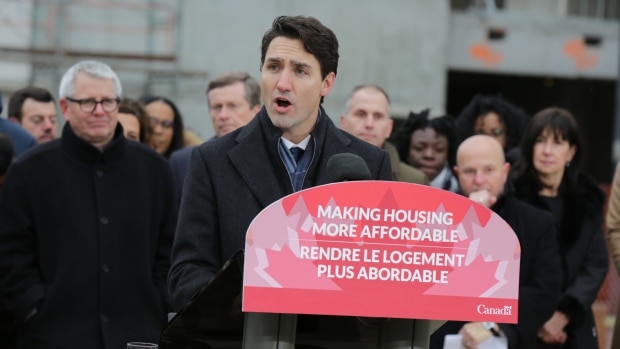 Prime Minister Trudeau announces a $40 billion dollar federal-provincial partnership deal to match the need for more affordable housing. Mr. Trudeau recently announced a $40 billion dollar federal-provincial partnership deal to match the need for more affordable housing with real substance. It was one of his promises in the last election. That will require provincial buy-in, something which would have been easier back when more provincial governments also wore the red party colours. Nevertheless it is an ambitious undertaking. And of course money alone will not solve the matter of housing affordability.
Demographics, tax and land use policies are the keys to shaping the future of housing and urban development period. Next week, in this column, we will explore options and entertain possible solutions as we put some meat onto these bones we’ve now laid bare.
 Ray Rivers writes weekly on both federal and provincial politics, applying his more than 25 years as a federal bureaucrat to his thinking. Rivers was a candidate for provincial office in Burlington in 1995. He was the founder of the Burlington citizen committee on sustainability at a time when climate warming was a hotly debated subject. Tweet @rayzrivers Ray Rivers writes weekly on both federal and provincial politics, applying his more than 25 years as a federal bureaucrat to his thinking. Rivers was a candidate for provincial office in Burlington in 1995. He was the founder of the Burlington citizen committee on sustainability at a time when climate warming was a hotly debated subject. Tweet @rayzrivers
Background links:
Population Growth – StatsCan Projections – Population of Canada–
Birth Rate in Canada – AIRBNB – Hong Kong Housing –
Bad Policies – Market Bubble – Housing Outlook –
Liberal Housing Election Promise – Housing Announcement –

 By Pepper Parr By Pepper Parr
December 8th, 2017
BURLINGTON, ON
Tom Muir was leaving city hall recently, heading to the parking lot and crossed paths with city manager James Ridge.
A conversation ensued. Muir describes his conversation with Ridge as “cordial”
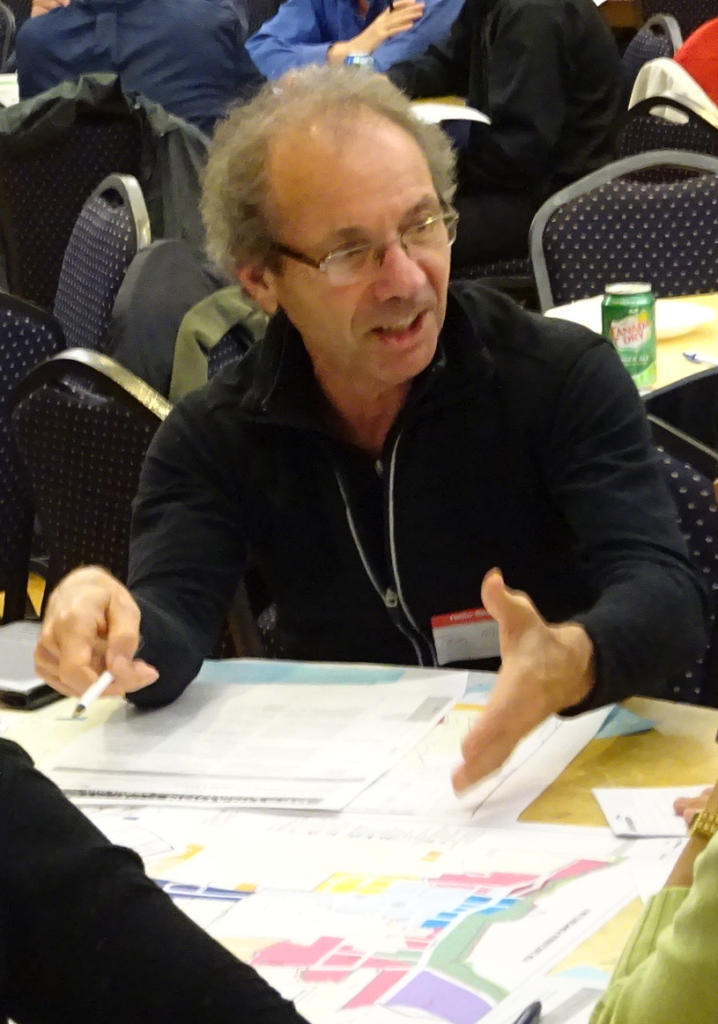 Tom Muir making a point Muir mentioned the verbal scuffle he had with Councillor Taylor over what Muir thought were points Taylor didn’t want to hear; that the city was using concepts that were not vetted and not approved on the 421 Brant project that was approved by the planning department and then passed by city council under the current Official Plan.
The city is in the process of writing a totally new Official Plan and was pushing very hard to get it done before the end of the year. The public began to push back even harder and the completion date for the new Official Plan, now in draft form is now uncertain.
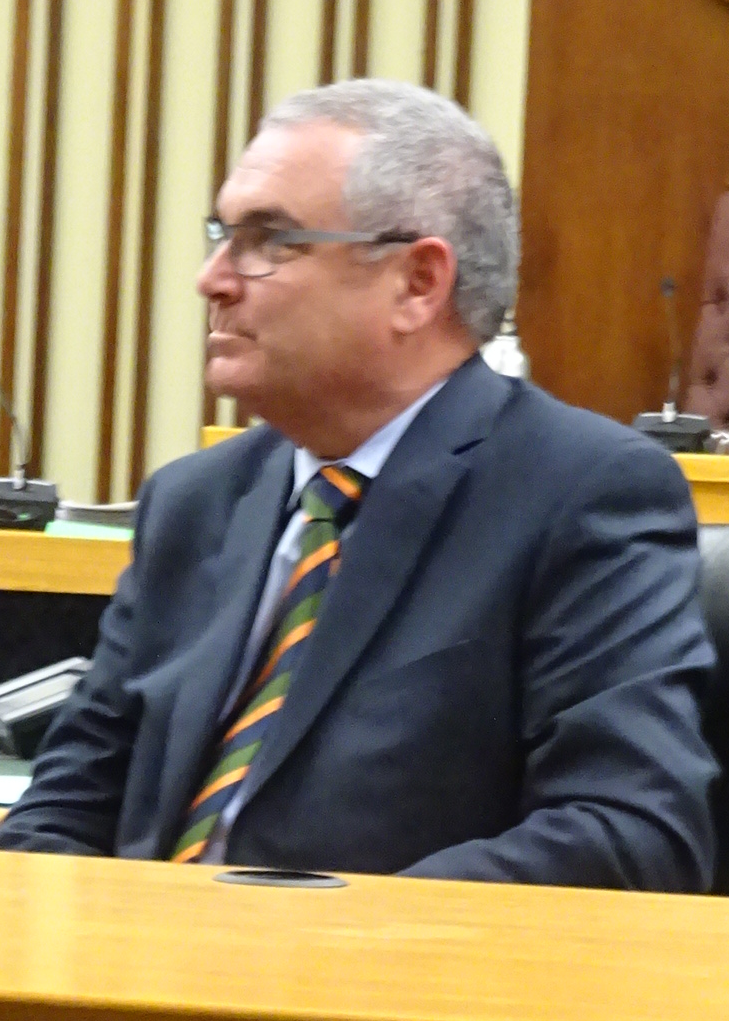 James Ridge at his first city council meeting. Muir says that Ridge immediately disagreed and asserted that it was a “negotiation”. Carriage Gate, the developer, had the right to build a 12 storey structure on the property they had assembled.
It has been described as an ugly squat building that used every square foot available. No one liked the look of the building but it was what the developer was allowed to do.
The city apparently came back with the tall building guidelines that call for podiums that were set back nicely from the property line, rose to four storeys and then had a tall skinny building that rose an additional 19 storeys.
The revised proposal Carriage Gate took to the planning department was for 27 storeys – the planners recommended 23 and that was what council bought on a 5-2 vote with the Mayor and Meed Ward dissenting..
Ridge said, according to Muir, that this is what was “negotiated”.
 Tom Muir, a frequent delegator at city hall. Muir said this was arbitrary and gave everyone around that table power they are not supposed to have if Official Plans and zoning bylaws that the public has bought into are to mean anything at all. Why have bylaws and height/density limits if the parties can just negotiate them away was Muir’s argument.
Muir said Ridge didn’t have a real answer, except he called that “good planning”, and added that he and Ridge talked about the economics, and the built form. They chose high and skinnier rather than shorter, squat, not the massing city wanted, and perhaps butt ugly, like the Sims building which Muir adds was his example not Ridge’s.
Muir’s view is this might be central to any OMB appeal case. Is it “good planning” to just ignore the determinative Official Plan and zoning bylaws and public opinion that gets expressed at required meetings that go way out of compliance and are rationalized as “negotiation”, when they appear to be no more than arbitrary decisions.
 James Ridge Burlington city manager. Muir said Ridge maintained that the existing Official Plan was designed to be “a negotiation” framework,
In my view, says Muir, this introduces arbitrary power to rules that are supposed to be complied with so that arbitrary is not in the cards to enable noncompliance. “That’s a door to corruption, like it or not.”
Muir makes an additional point.
What Carnicelli didn’t say in his delegation was that Carriage Gate began assembling property for this project ten years ago and that they at one point took a proposal to the Planning department that met the 12 storey limit many people want.
It was a pretty plain looking building that used every possible foot of the property – not much in the way of a street-scape – but it met the rules.
The developer and the Planning department worked together to come up with the structure that met the tall building guide lines that were new and the developer revised the proposal.
City council decided it was what the city needed and voted for it; with two exceptions, the Mayor and Councillor for the ward.
Now, as a citizen, ask yourself this; would you rather have an 11-storey mass (I believe this is the ugly that Mr. Ridge is referring to) or a 23-storey building, 19 storeys in a slender tower? Consider that the 11-storey building is at the property lines and the tall building is set back (wider sidewalks) and the bulk of the tall building is set back once you pass the podium.
Why are we beating up the developer?
The City has never seen anything like this!

|
|
 By Staff
By Staff













 The effects of the rules and definitions in the new Official Plan requires detailed study, and the public needs much more time to provide proper feedback to council. As one quick example – at first the coloured map (Schedule C) shows pink for “Neighbourhood Centre”, and would seem to protect those traditional commercial sites. This is until you realize that the “Neighbourhood Centre” designation requires re-development to “To ensure the in-filling of surface parking lots (8.1.3.4.1.f).”
The effects of the rules and definitions in the new Official Plan requires detailed study, and the public needs much more time to provide proper feedback to council. As one quick example – at first the coloured map (Schedule C) shows pink for “Neighbourhood Centre”, and would seem to protect those traditional commercial sites. This is until you realize that the “Neighbourhood Centre” designation requires re-development to “To ensure the in-filling of surface parking lots (8.1.3.4.1.f).” Some of the rules attempt to distort the free market further and remove surface parking in exchange for allowing 12 story buildings on the site. It’s completely unclear what replaces all these traditional commercial sites, or how the commodities of living are to be acquired.
Some of the rules attempt to distort the free market further and remove surface parking in exchange for allowing 12 story buildings on the site. It’s completely unclear what replaces all these traditional commercial sites, or how the commodities of living are to be acquired. It seems as if the current population is to just blindly begin these changes then endure whatever local fallout occurs.
It seems as if the current population is to just blindly begin these changes then endure whatever local fallout occurs.
 Greg Woodruff is an Aldershot resident who ran for the office of Regional Chair in the 2014 municipal election. He delegates frequently at city council.
Greg Woodruff is an Aldershot resident who ran for the office of Regional Chair in the 2014 municipal election. He delegates frequently at city council. Without a doubt, 2017 was a year of some turmoil in our community. Two of our schools are on the chopping block and the campaign of the Halton District School Board to close schools come hell or high water has without a doubt been a source of civil conflict in our community.
Without a doubt, 2017 was a year of some turmoil in our community. Two of our schools are on the chopping block and the campaign of the Halton District School Board to close schools come hell or high water has without a doubt been a source of civil conflict in our community.
 The next 12 months promise plenty of excitement. First, in June we will have a provincial election, which will bring fevered campaigning through the spring. Then, Burlington will hold its municipal election on 22 October along with the rest of Ontario. This one looks like it’s going to be interesting, with multiple competitive candidates for the Mayorship, and a strong probability that city council will not be fully re-elected as it was in 2014.
The next 12 months promise plenty of excitement. First, in June we will have a provincial election, which will bring fevered campaigning through the spring. Then, Burlington will hold its municipal election on 22 October along with the rest of Ontario. This one looks like it’s going to be interesting, with multiple competitive candidates for the Mayorship, and a strong probability that city council will not be fully re-elected as it was in 2014. Rory Nisan is a long-time Burlington resident and Lester B. Pearson High School alumnus. He has been an active member of the Save Pearson community organization.
Rory Nisan is a long-time Burlington resident and Lester B. Pearson High School alumnus. He has been an active member of the Save Pearson community organization. There were two media releases today, that are not news but, point out to two changes the province has put in place that make sense in their own right and are examples of good government policy – they were the increase in the minimum wage to $14 an hour and a better deal for the minimum wage workers in terms of the time they can take off for sick days and personal matters.
There were two media releases today, that are not news but, point out to two changes the province has put in place that make sense in their own right and are examples of good government policy – they were the increase in the minimum wage to $14 an hour and a better deal for the minimum wage workers in terms of the time they can take off for sick days and personal matters. The other is described as OHIP plus which gives people under 25 all kinds of pharmaceuticals free of charge.
The other is described as OHIP plus which gives people under 25 all kinds of pharmaceuticals free of charge.

















 Ray Rivers writes weekly on both federal and provincial politics, applying his more than 25 years as a federal bureaucrat to his thinking. Rivers was a candidate for provincial office in Burlington in 1995. He was the founder of the Burlington citizen committee on sustainability at a time when climate warming was a hotly debated subject. Tweet @rayzrivers
Ray Rivers writes weekly on both federal and provincial politics, applying his more than 25 years as a federal bureaucrat to his thinking. Rivers was a candidate for provincial office in Burlington in 1995. He was the founder of the Burlington citizen committee on sustainability at a time when climate warming was a hotly debated subject. Tweet @rayzrivers









 When an elected leader does not listen to their constituents, they are not respecting their constituents. Leadership that believes it “knows best” has a deleterious effect on our democratic institutions.
When an elected leader does not listen to their constituents, they are not respecting their constituents. Leadership that believes it “knows best” has a deleterious effect on our democratic institutions.








 No it’s the $40 billion dollar ten year affordable housing strategy which is to kick in sometime after the next election, providing the provinces kick in their shares as well. The details are scarce but putting that much money in the hands of people who are finding it hard to get affordable accommodation will be a huge economic stimulus for the country.
No it’s the $40 billion dollar ten year affordable housing strategy which is to kick in sometime after the next election, providing the provinces kick in their shares as well. The details are scarce but putting that much money in the hands of people who are finding it hard to get affordable accommodation will be a huge economic stimulus for the country. Perhaps that is why Trudeau is delaying the start up until 2020. Cynics will note that this is also an early 2019 election promise. But after the run-up in house prices recently nobody should argue that there is a problem with affordability, certainly for single homes. And as house prices go, so too must go rental costs eventually.
Perhaps that is why Trudeau is delaying the start up until 2020. Cynics will note that this is also an early 2019 election promise. But after the run-up in house prices recently nobody should argue that there is a problem with affordability, certainly for single homes. And as house prices go, so too must go rental costs eventually.







 As of Jan. 1, 2018 Roads and Parks Maintenance will become the Roads, Parks and Forestry Department; with Mary Battaglia as lead.
As of Jan. 1, 2018 Roads and Parks Maintenance will become the Roads, Parks and Forestry Department; with Mary Battaglia as lead.



 Some at the meeting felt it was “totally out of compliance with the existing Official Plan and bylaws” and was being promoted as “in alignment with city proposals for the Mobility Hub.”
Some at the meeting felt it was “totally out of compliance with the existing Official Plan and bylaws” and was being promoted as “in alignment with city proposals for the Mobility Hub.”








 Jeremy Skinner is a Burlington resident who is a frequent contributor to the opinion pages of the Gazette.
Jeremy Skinner is a Burlington resident who is a frequent contributor to the opinion pages of the Gazette.












